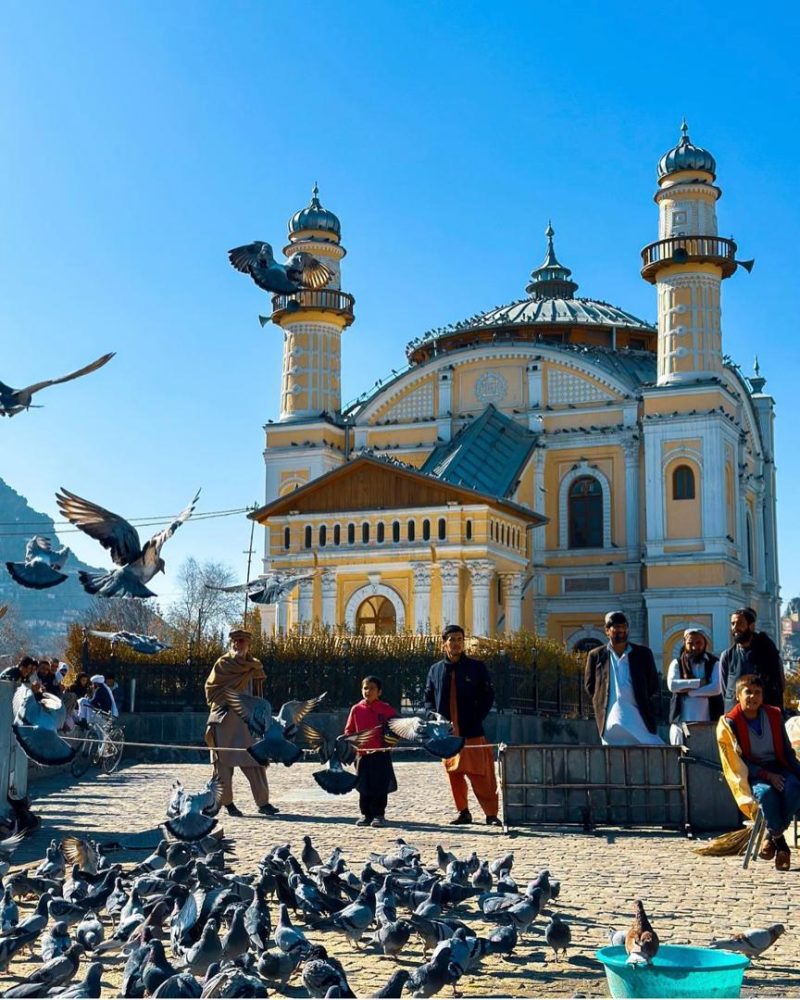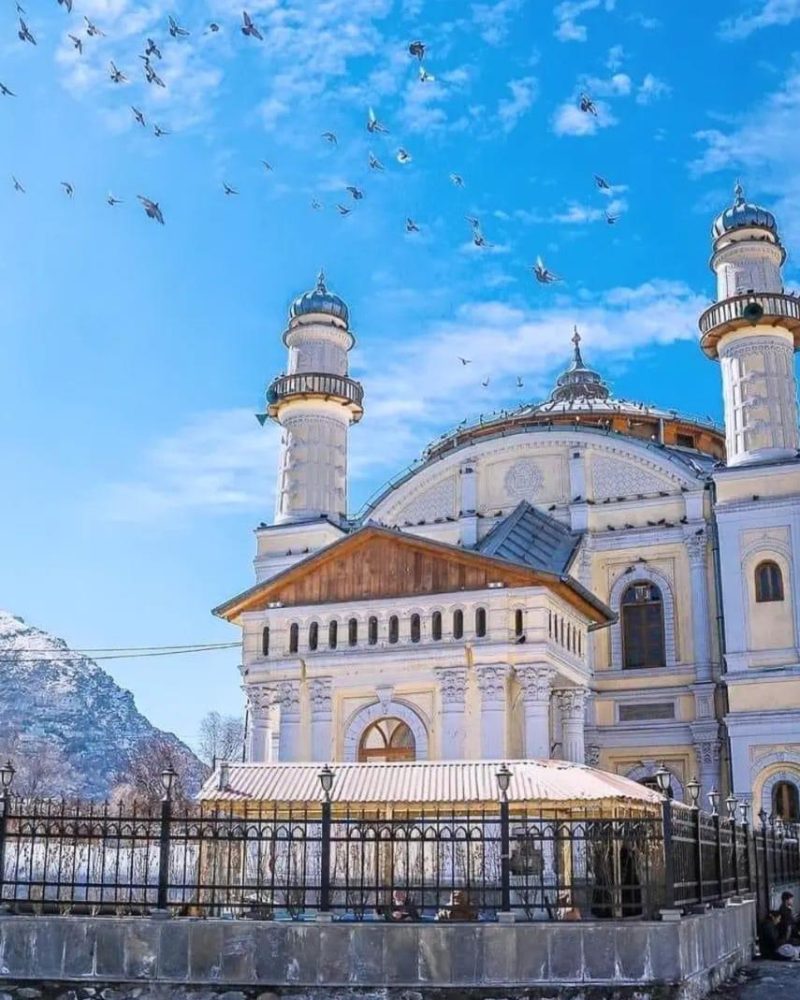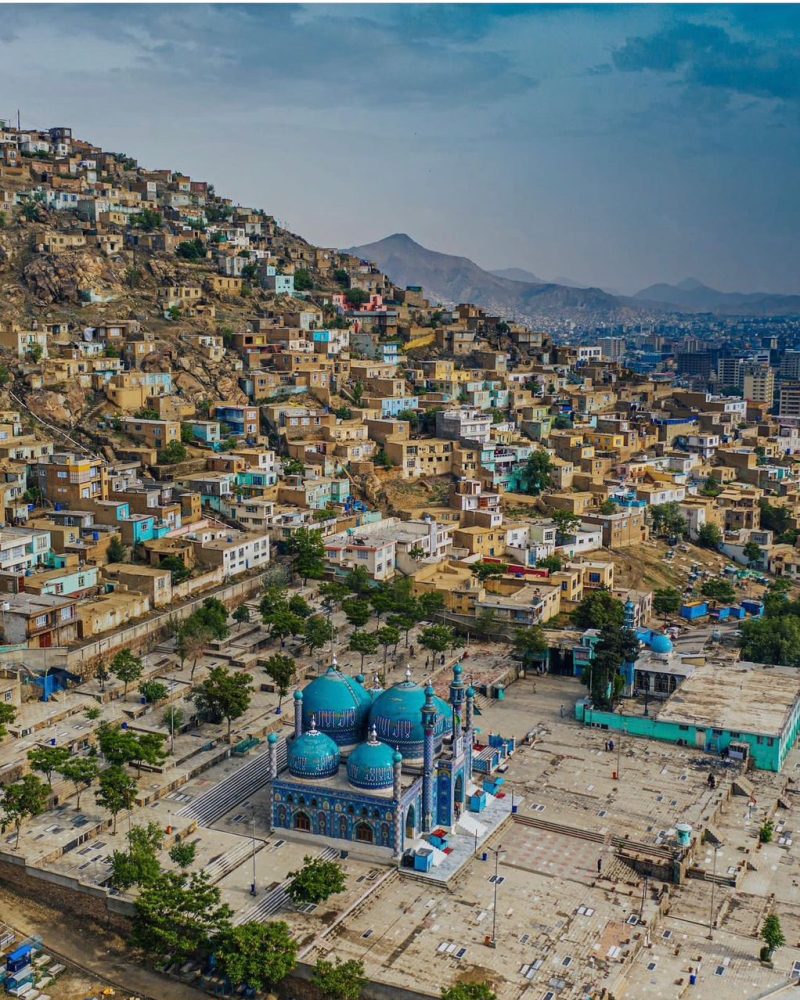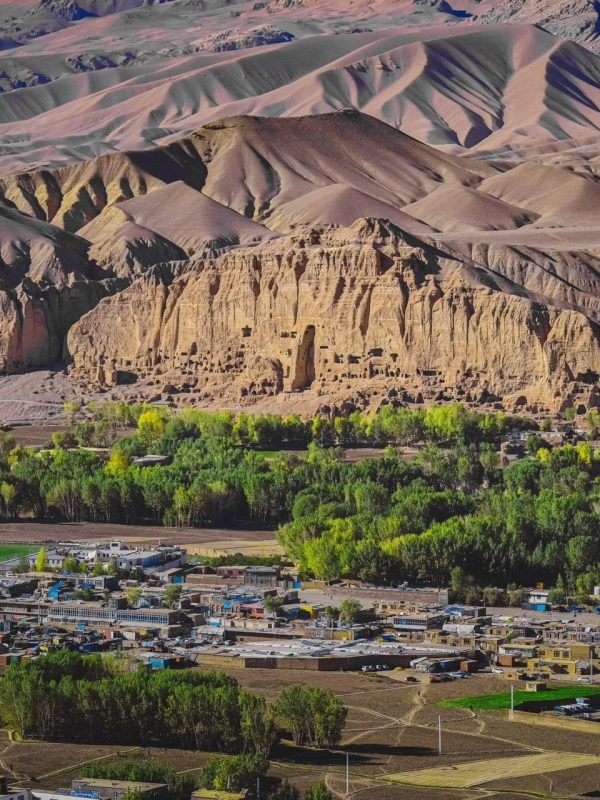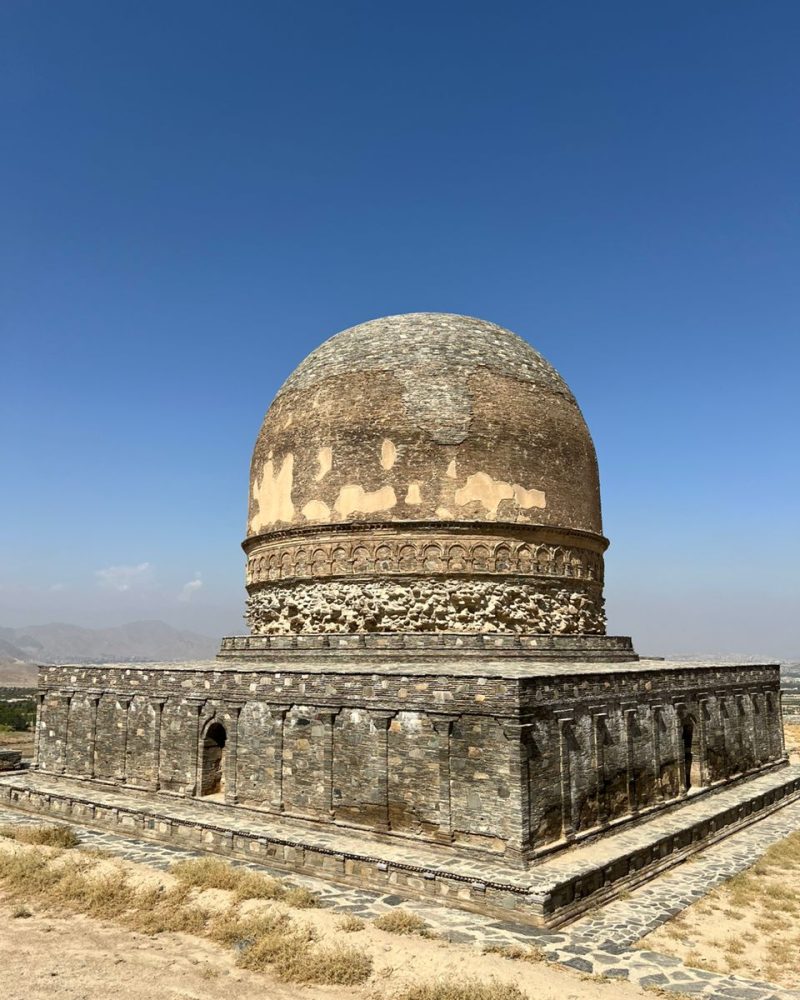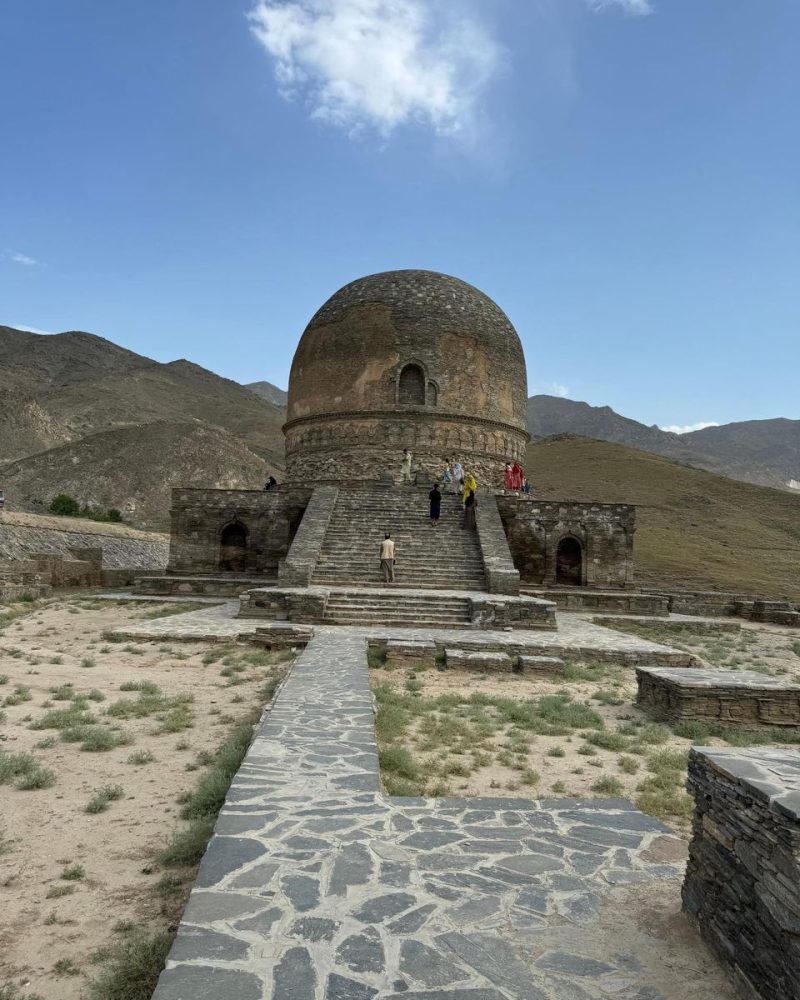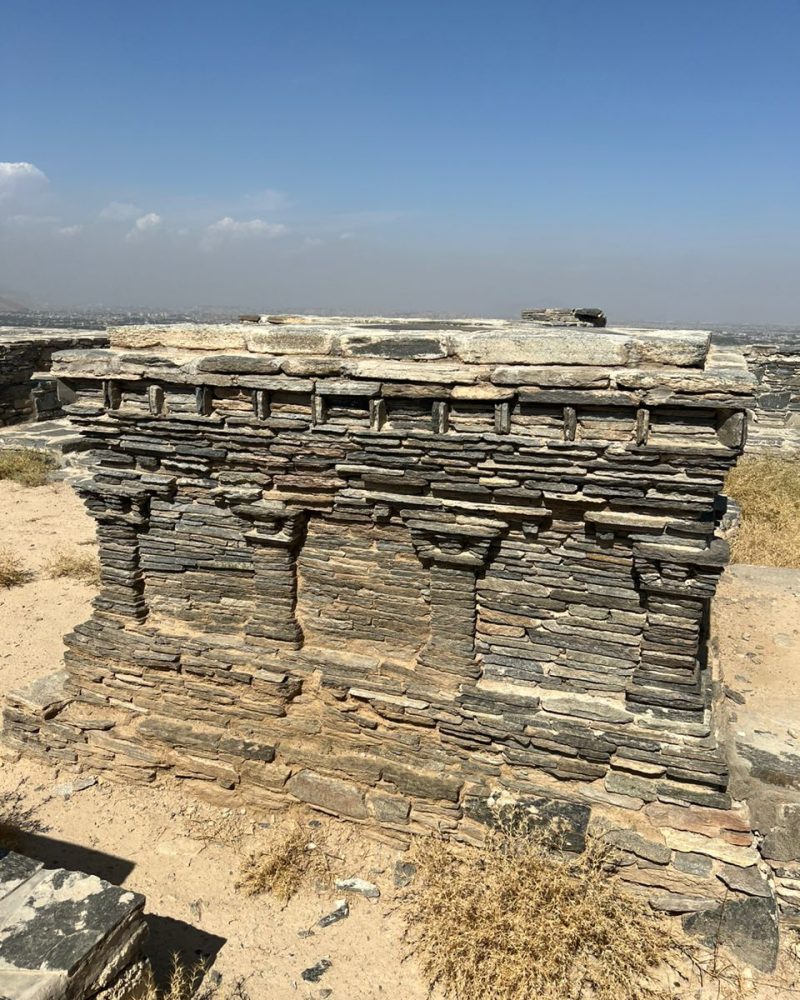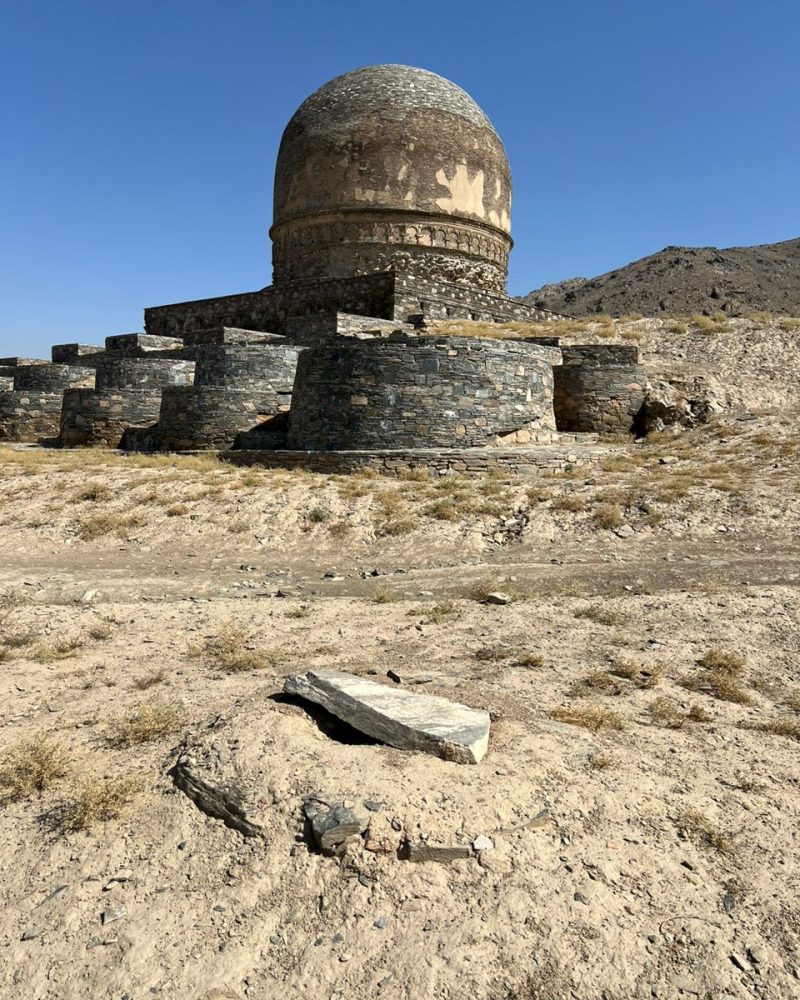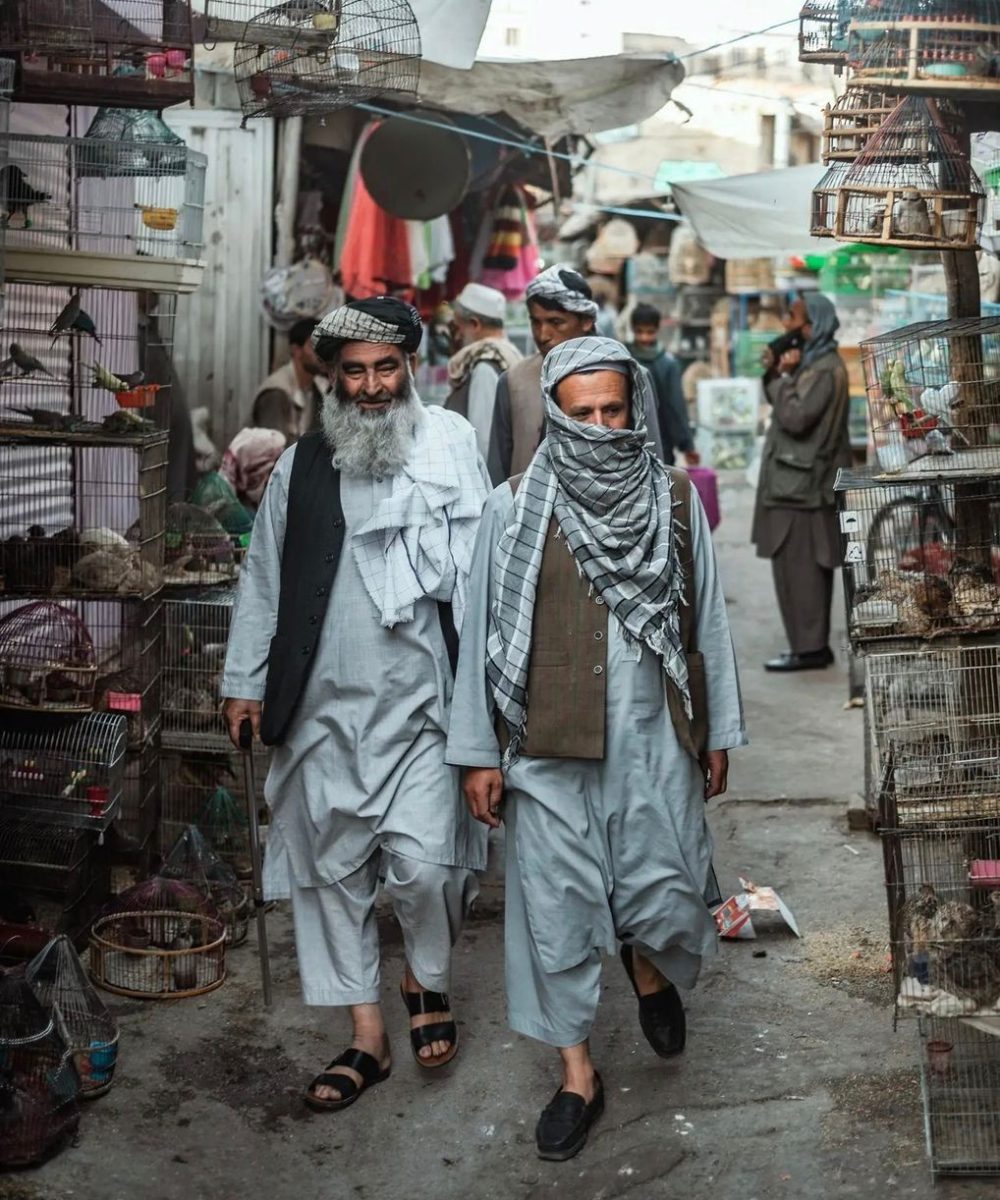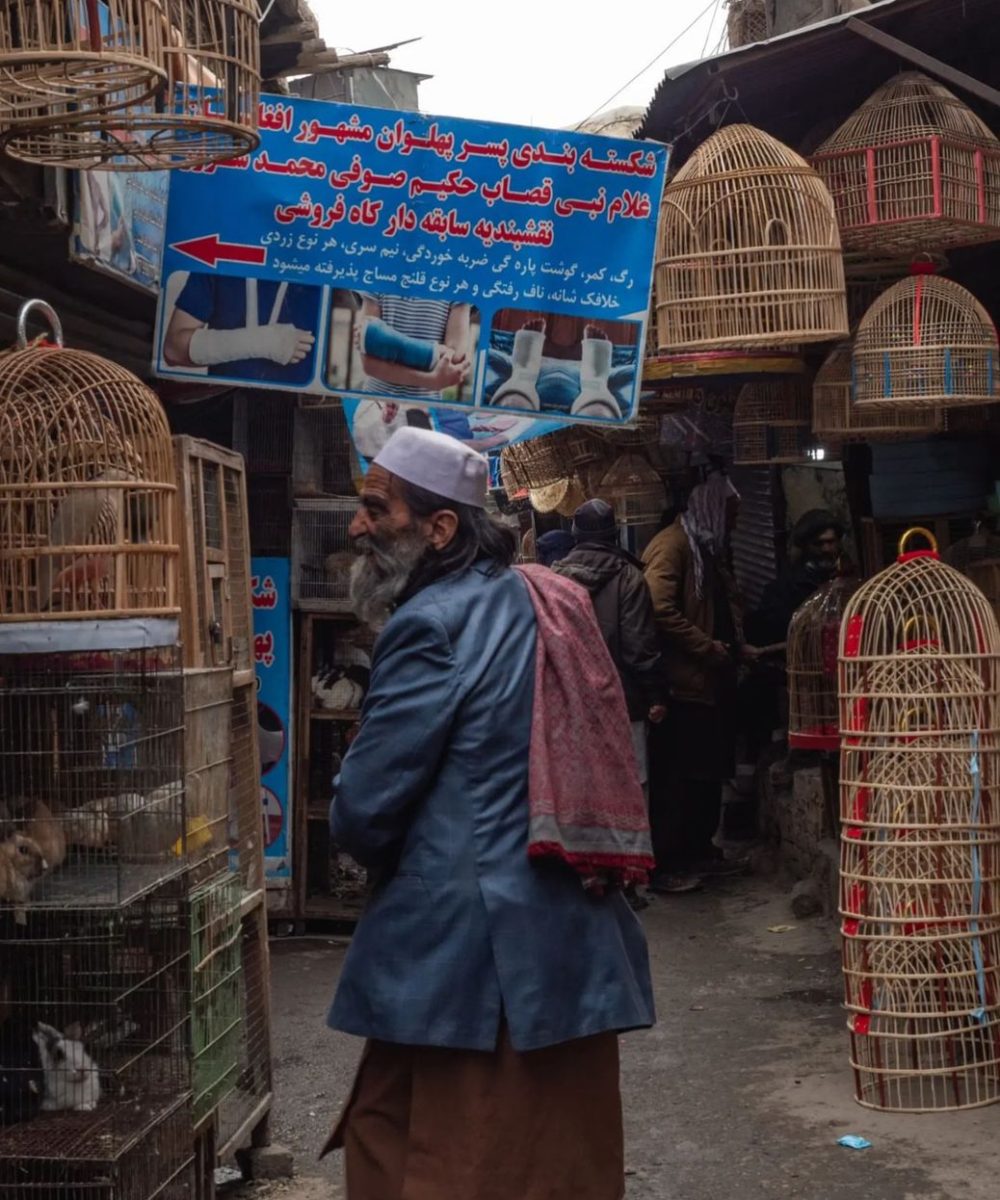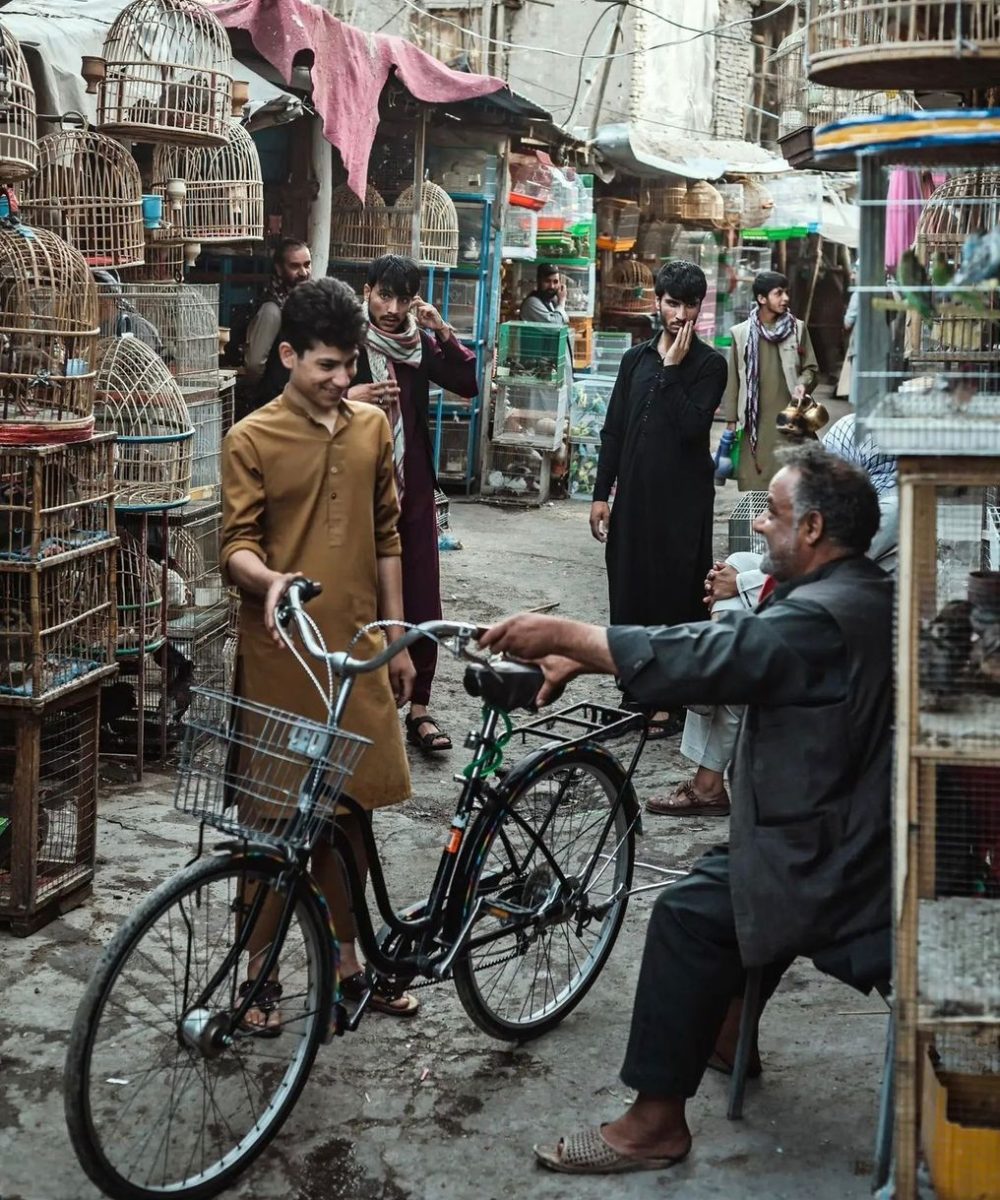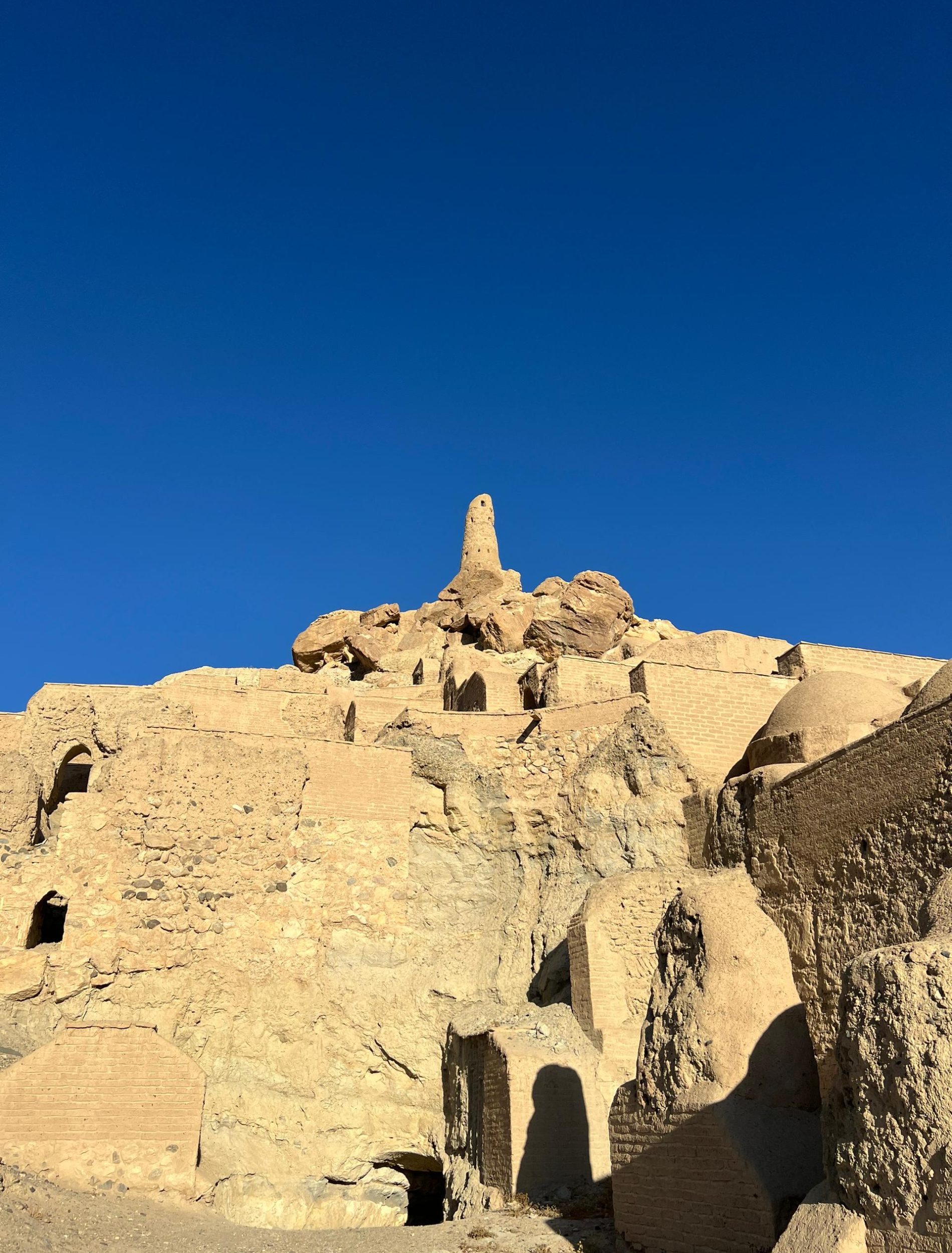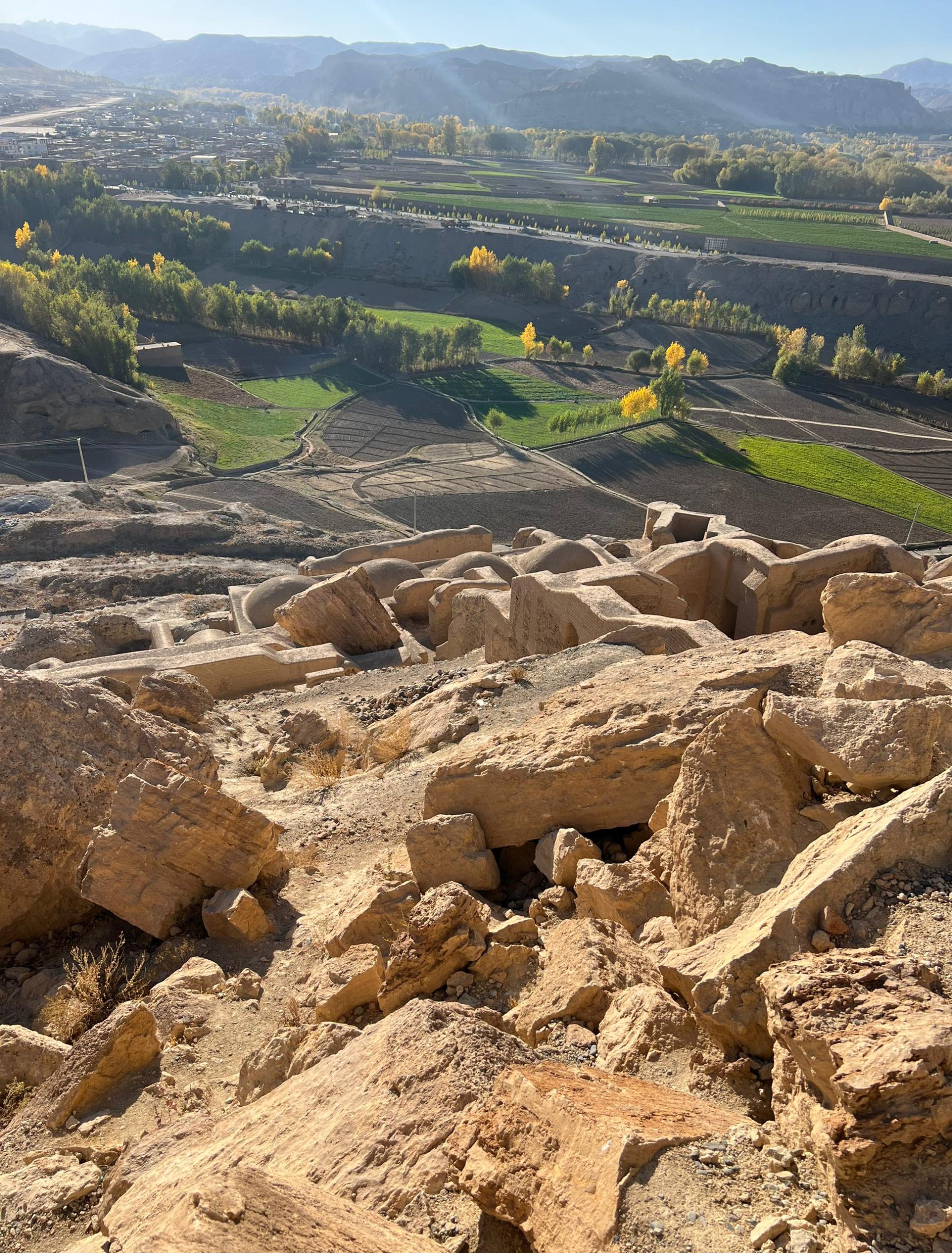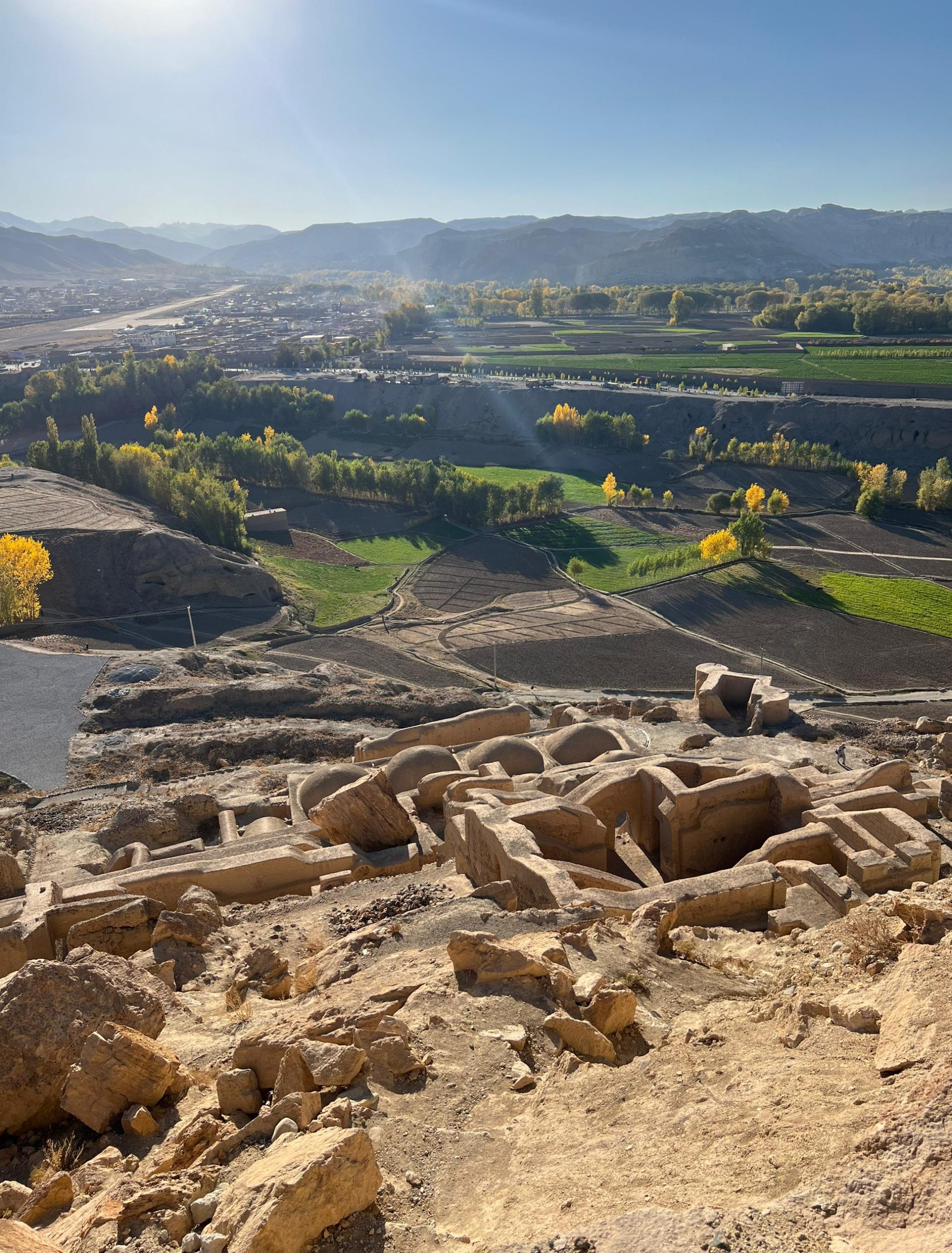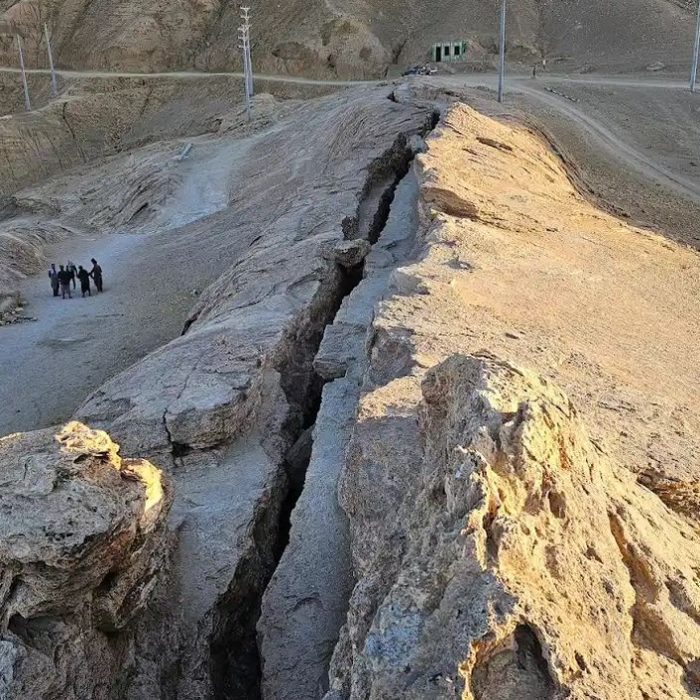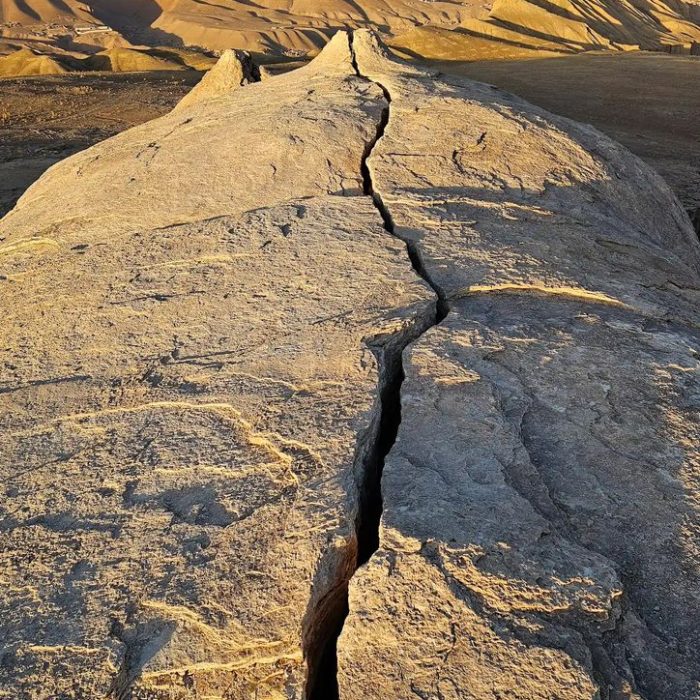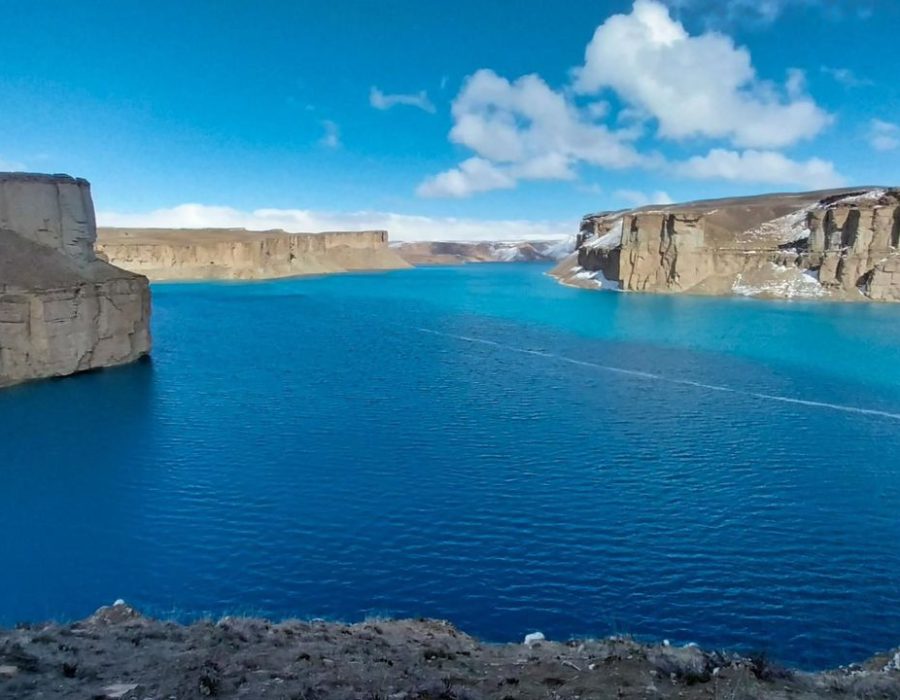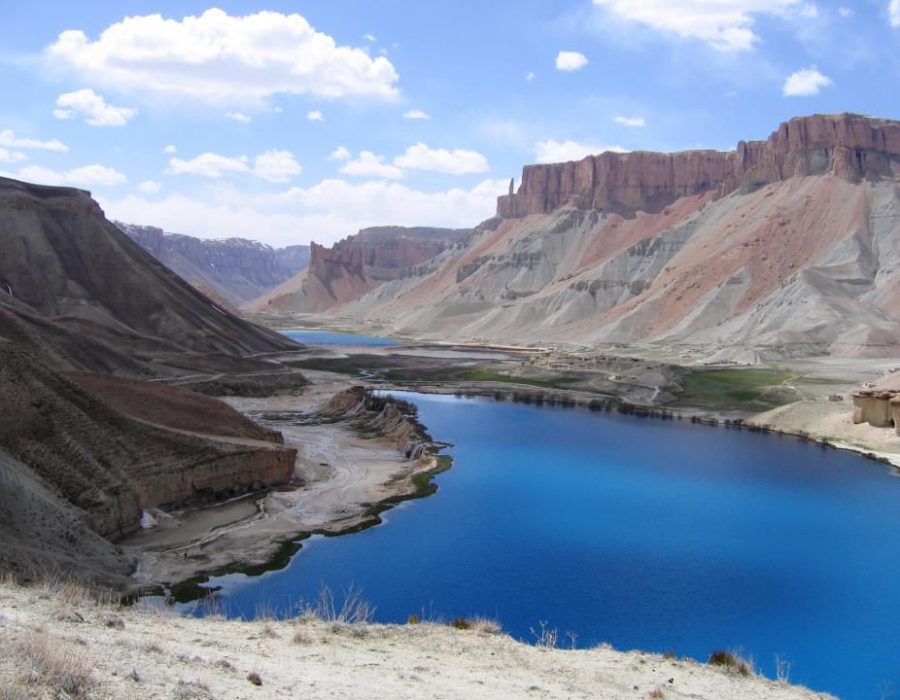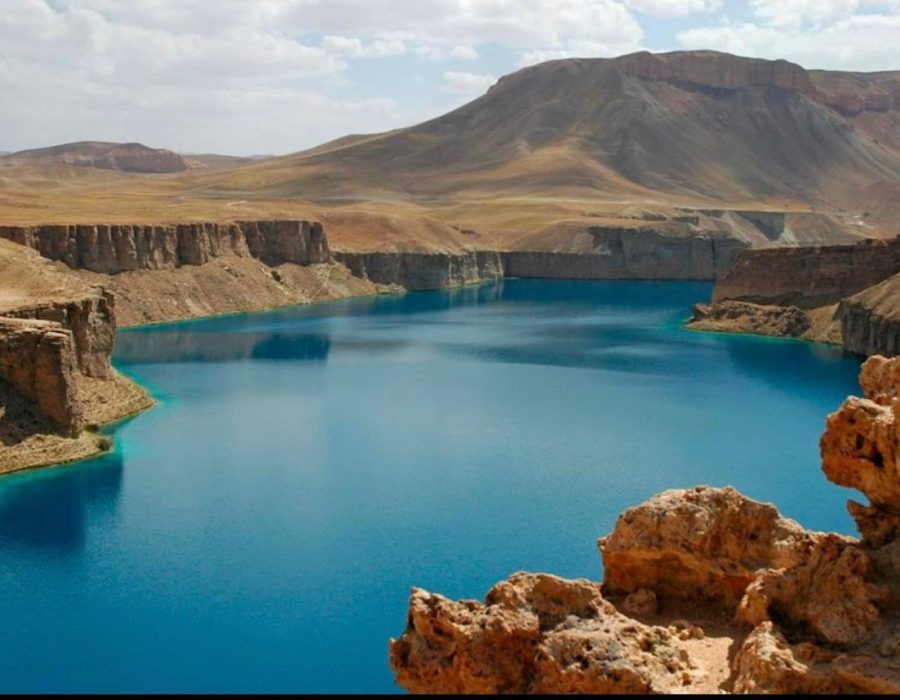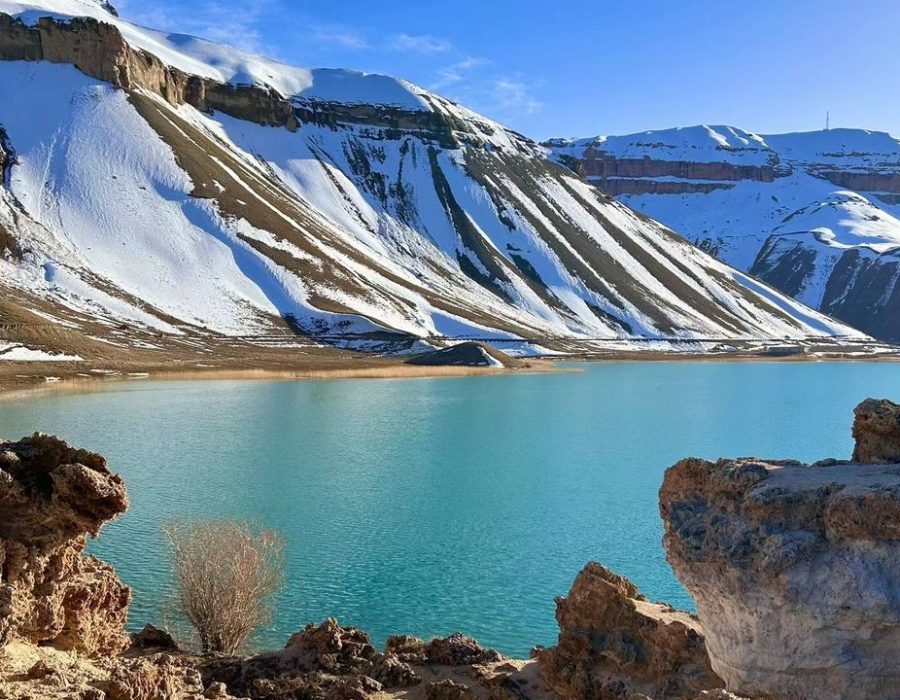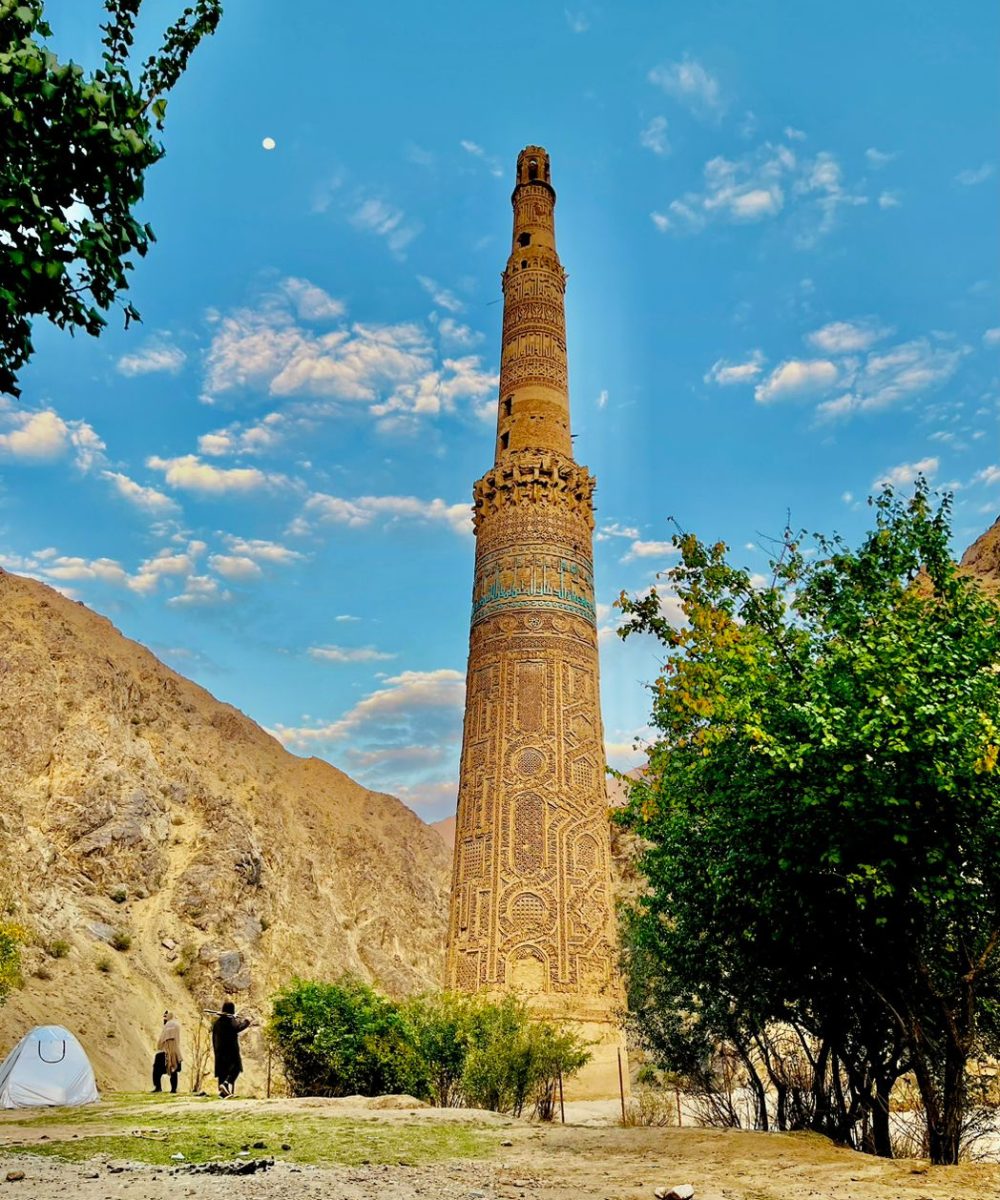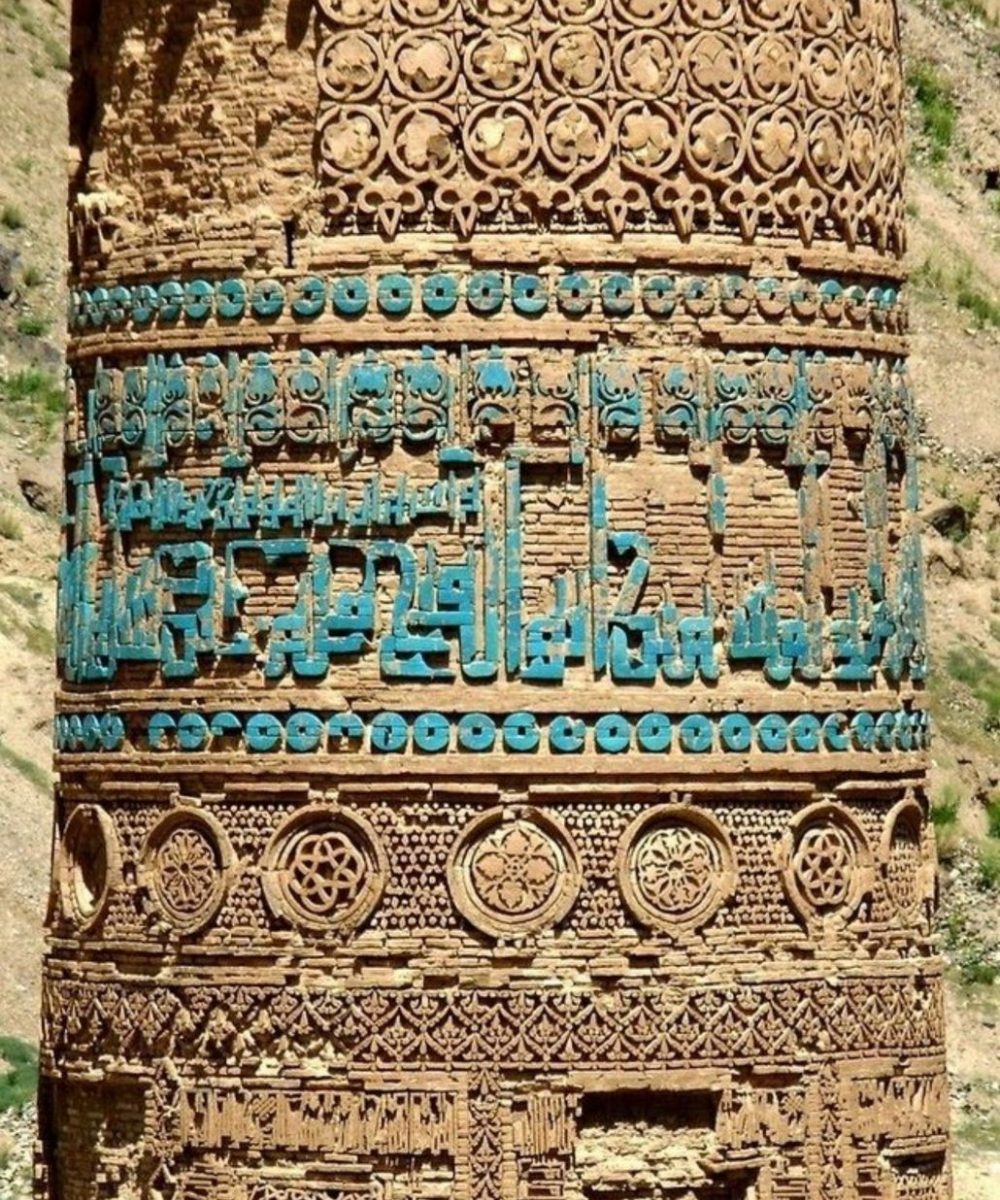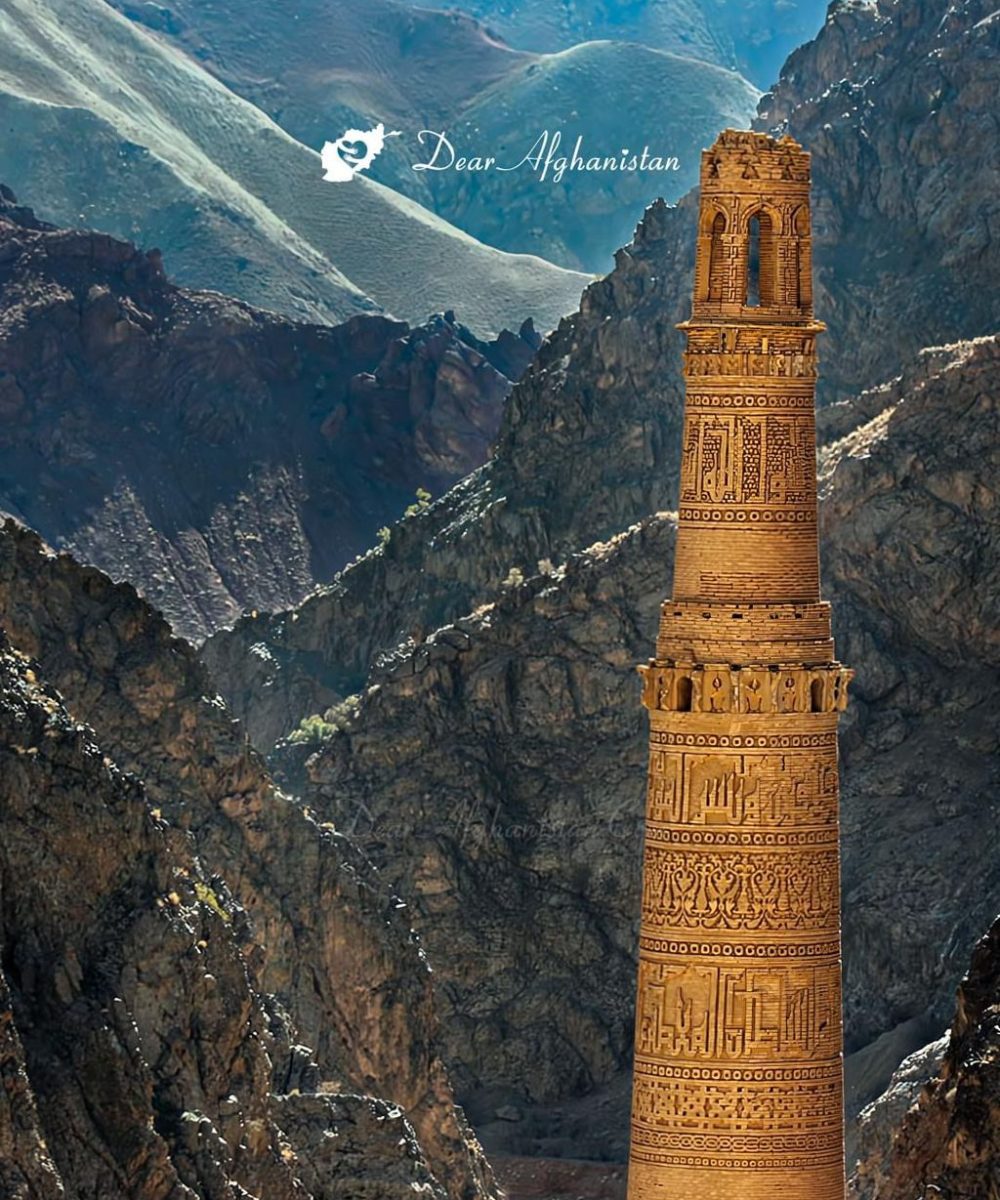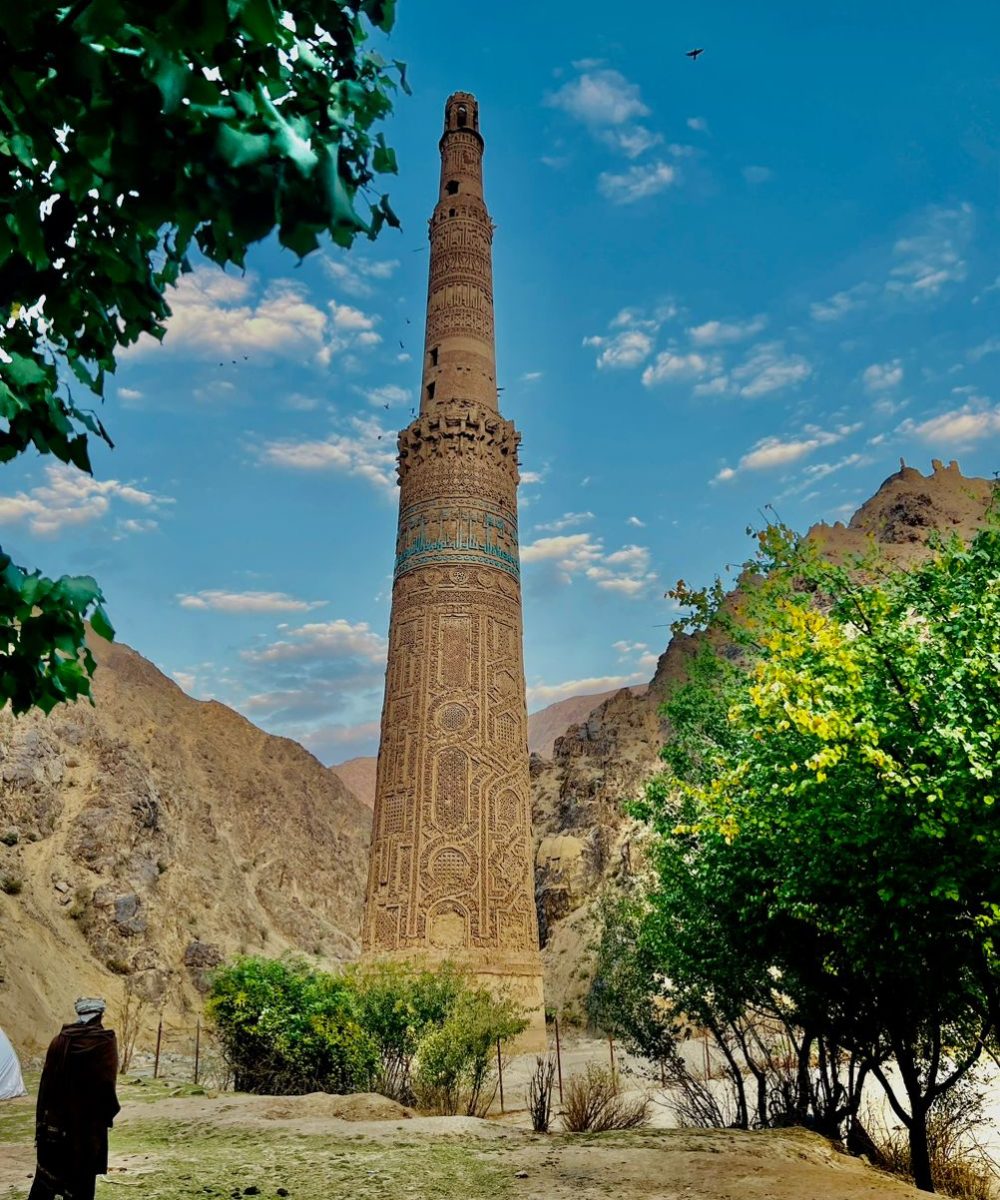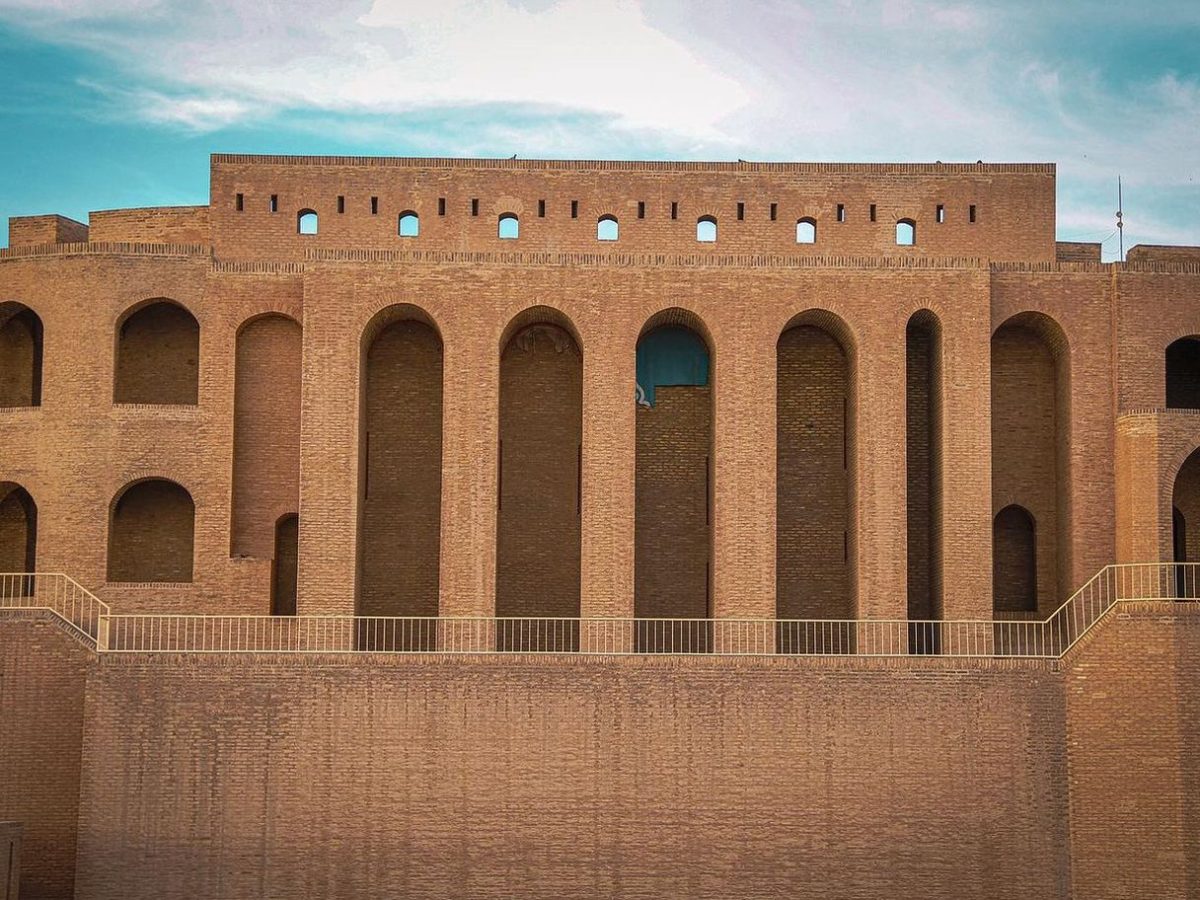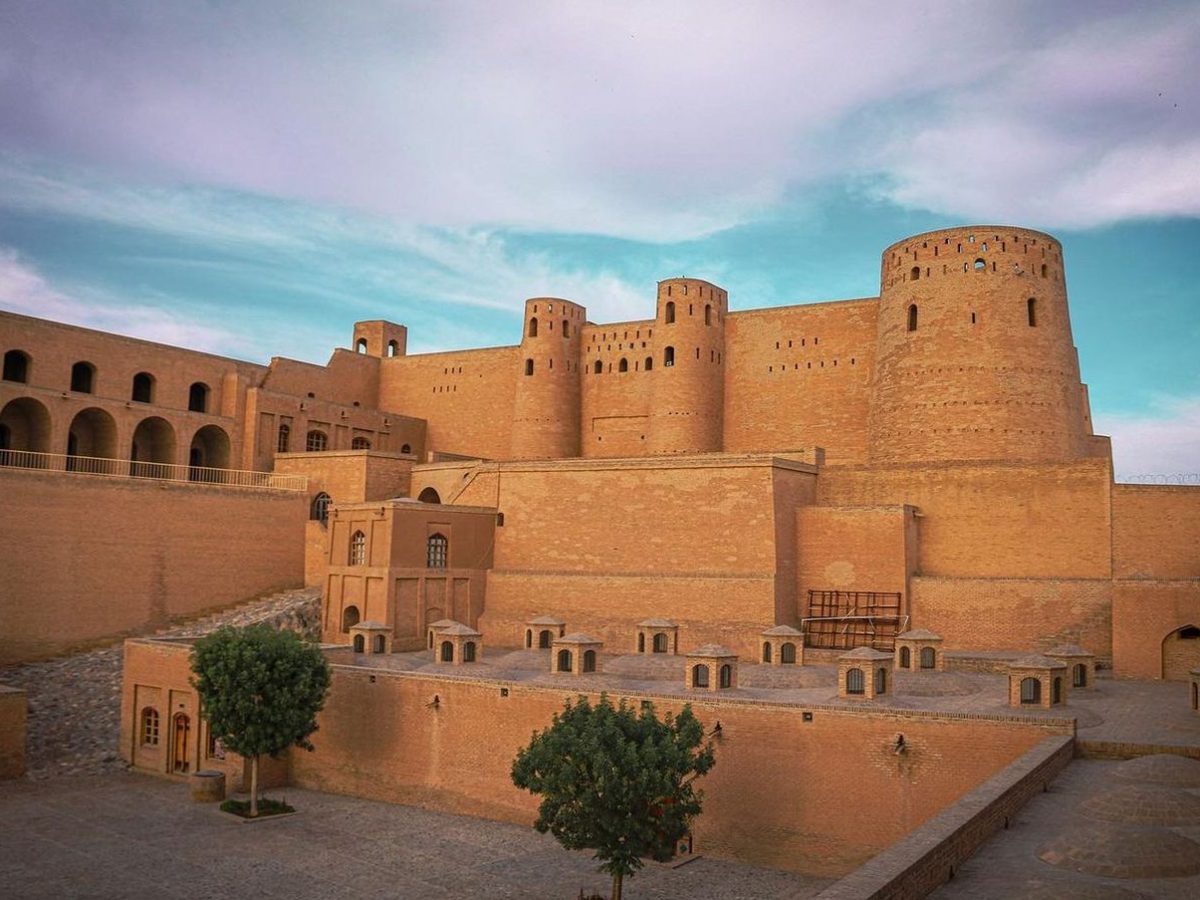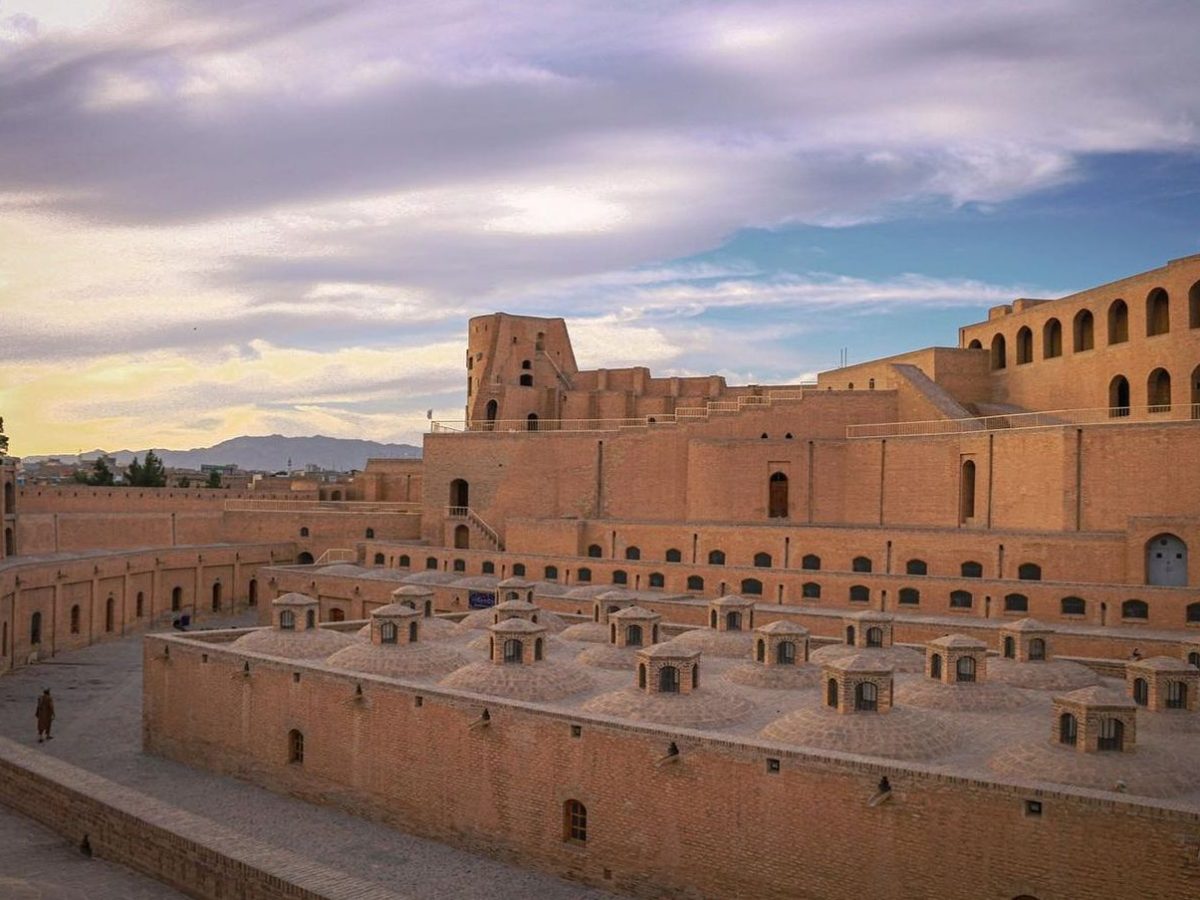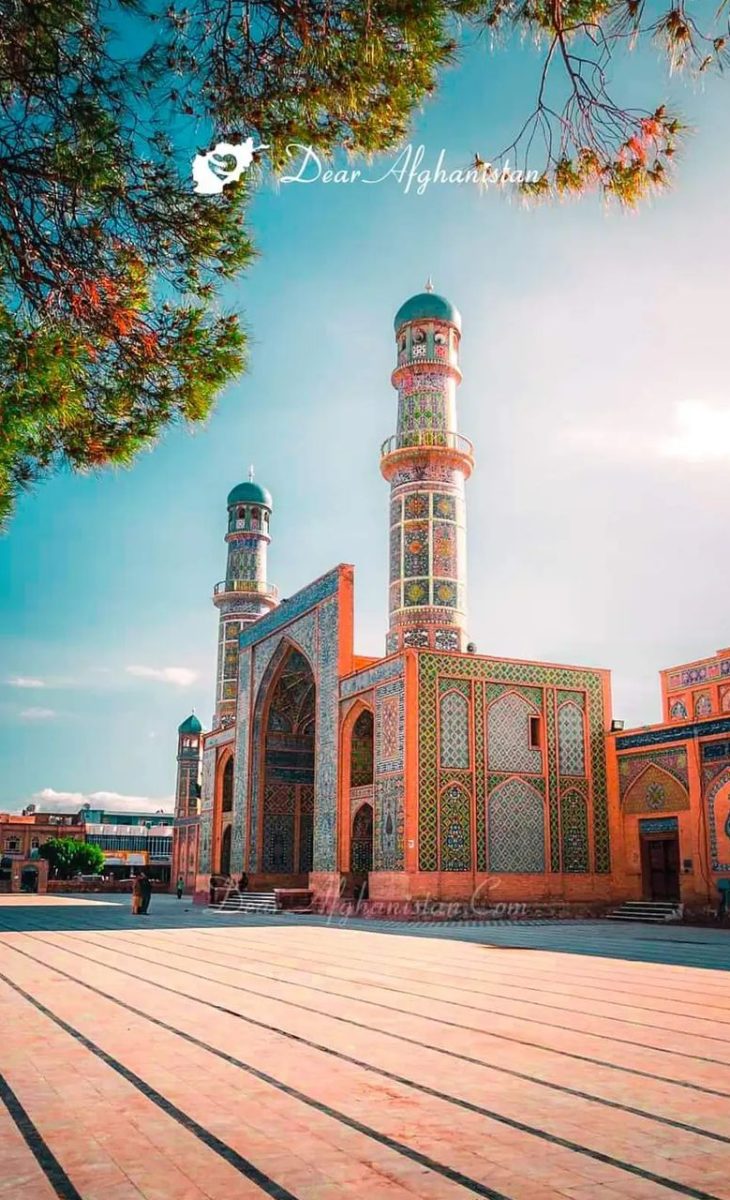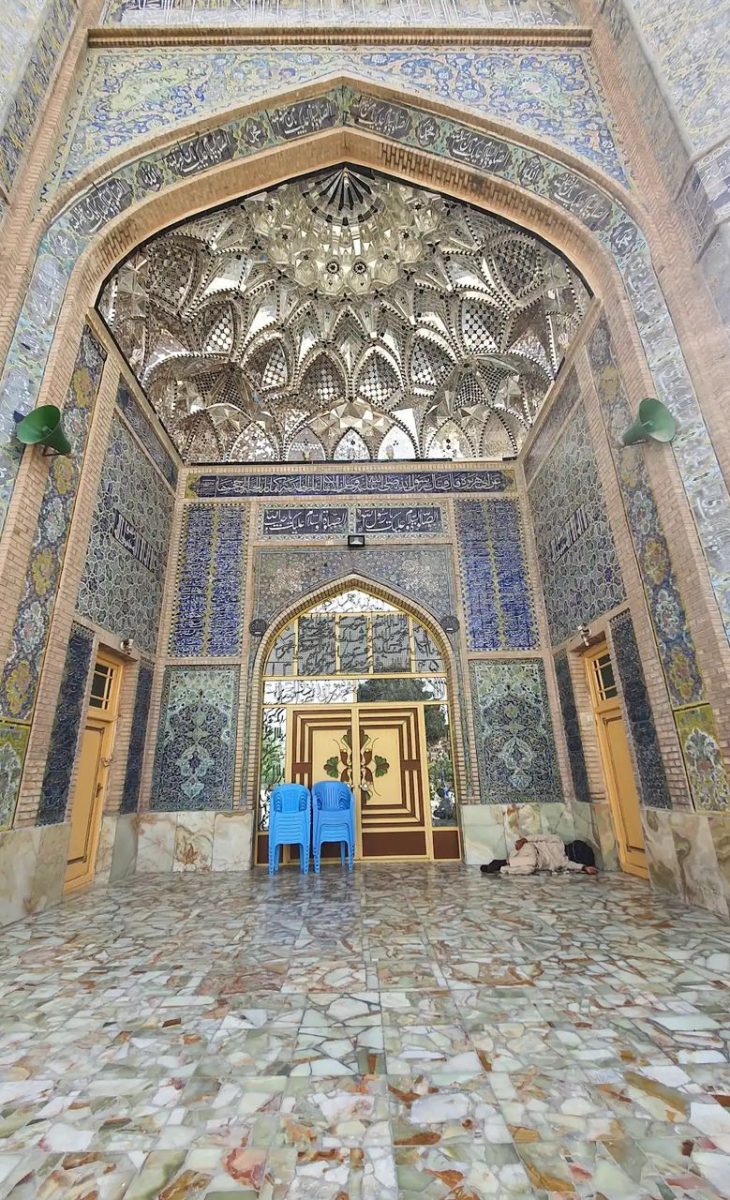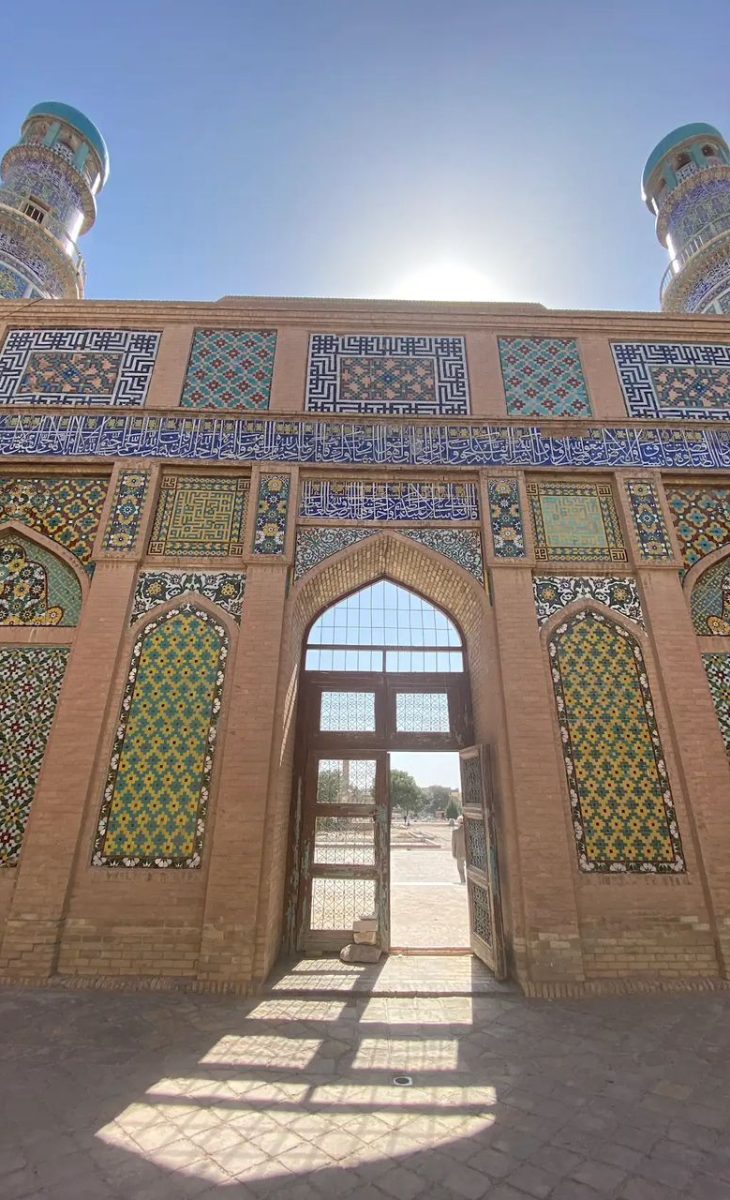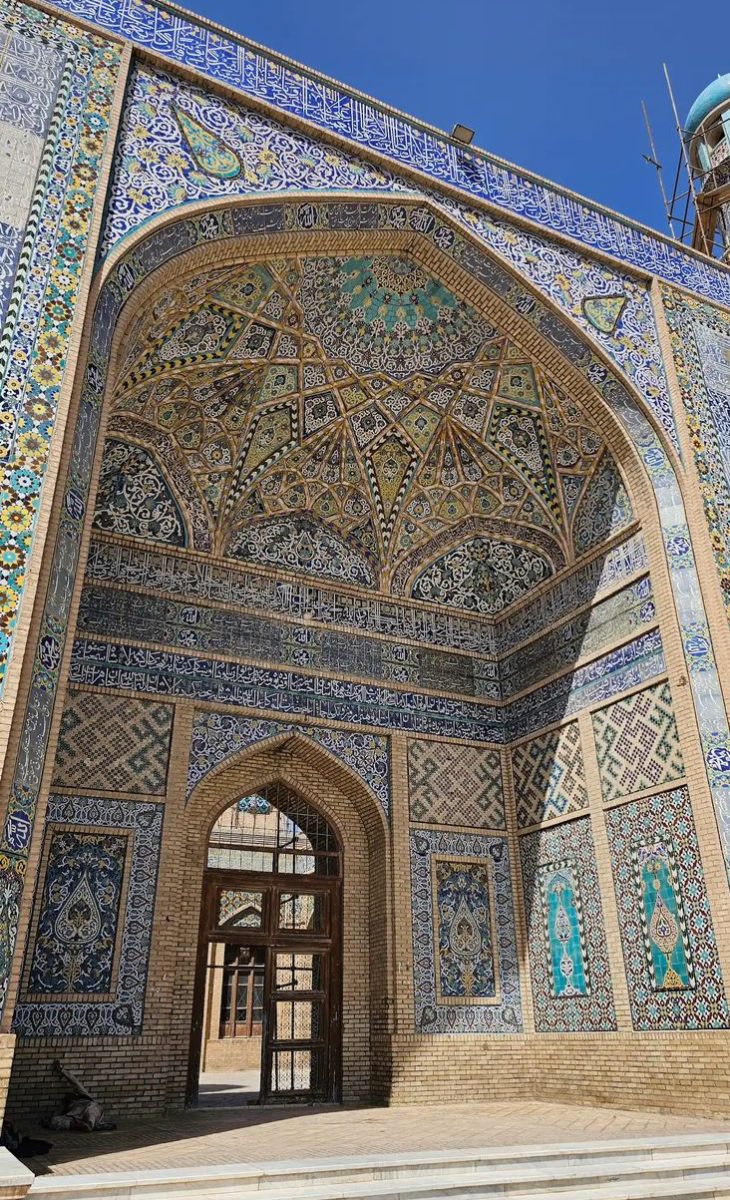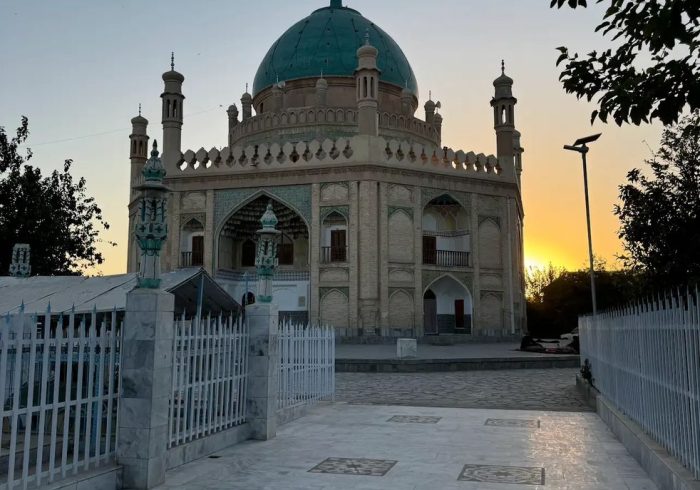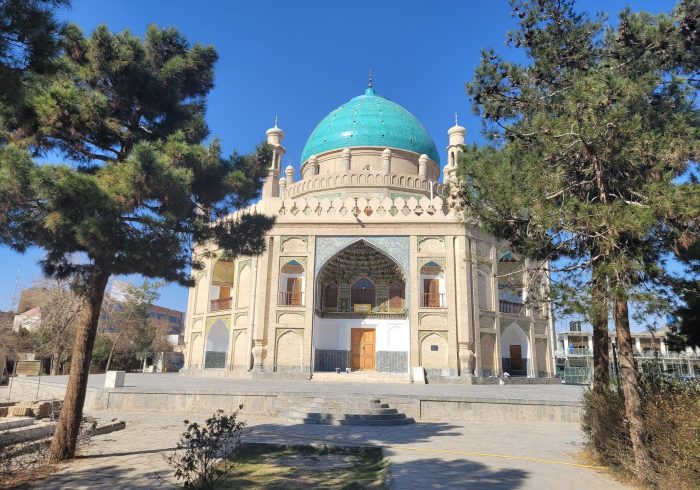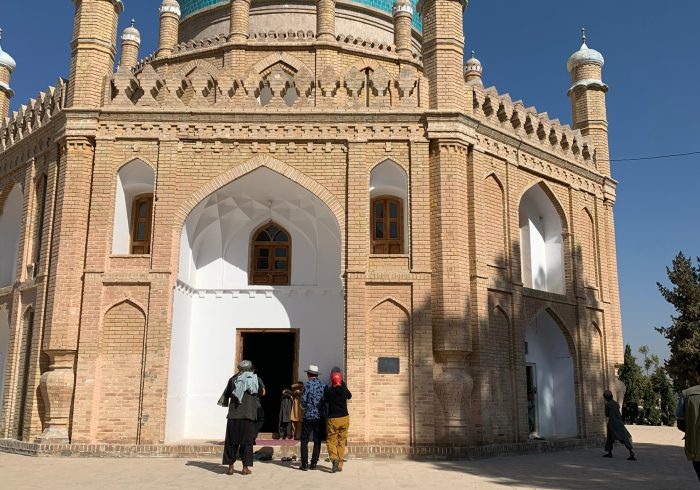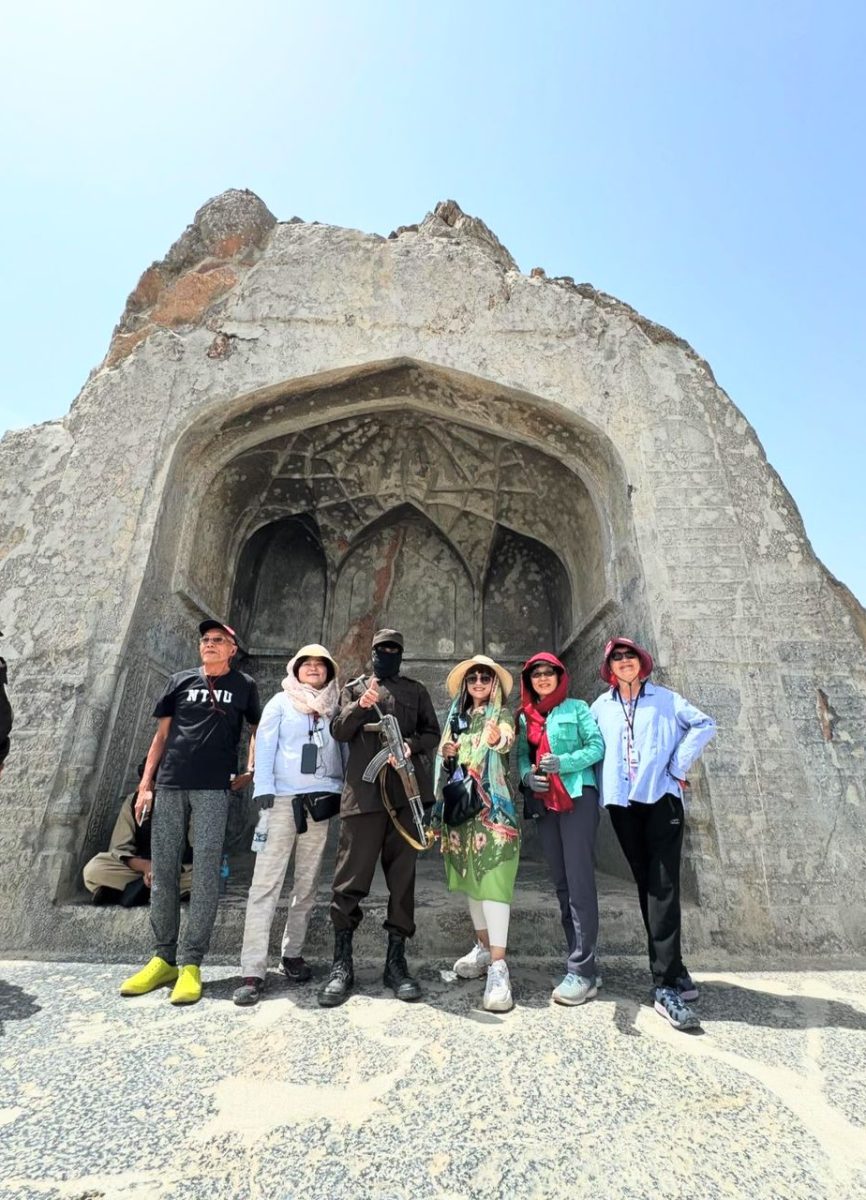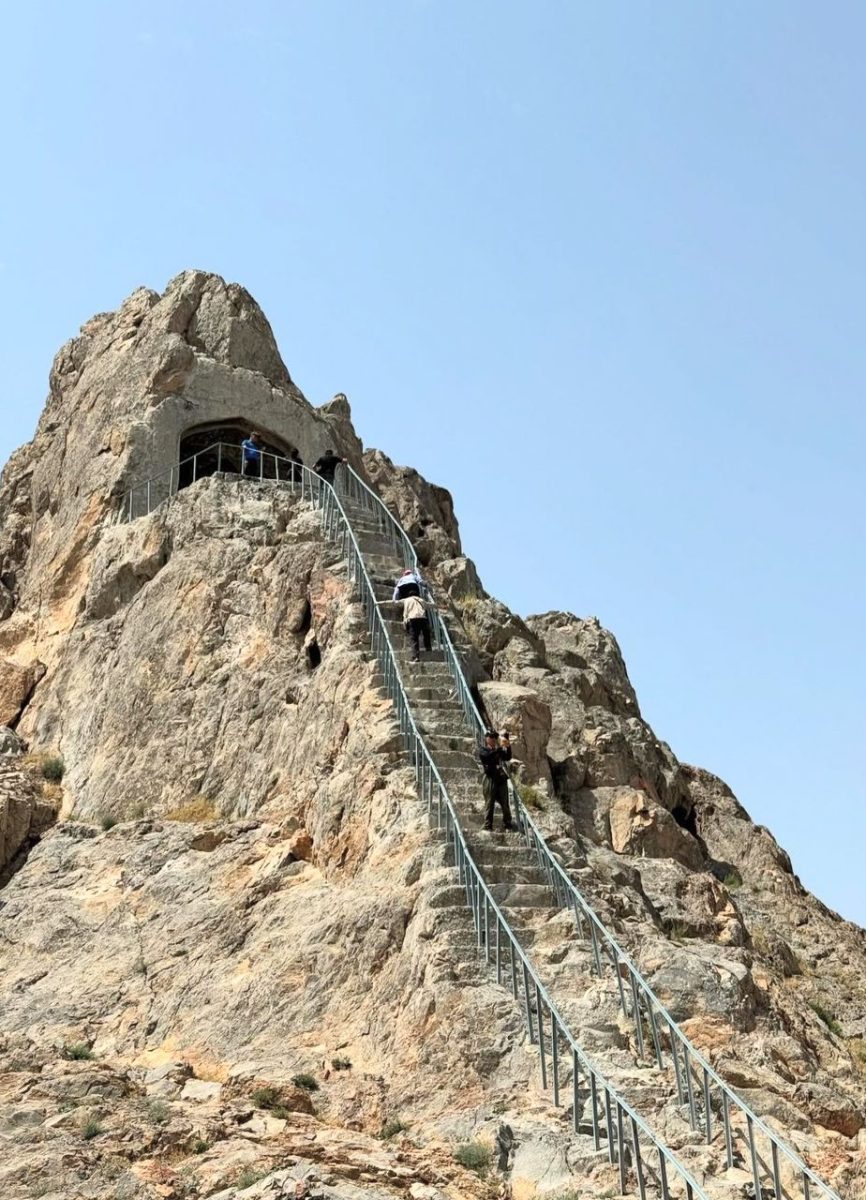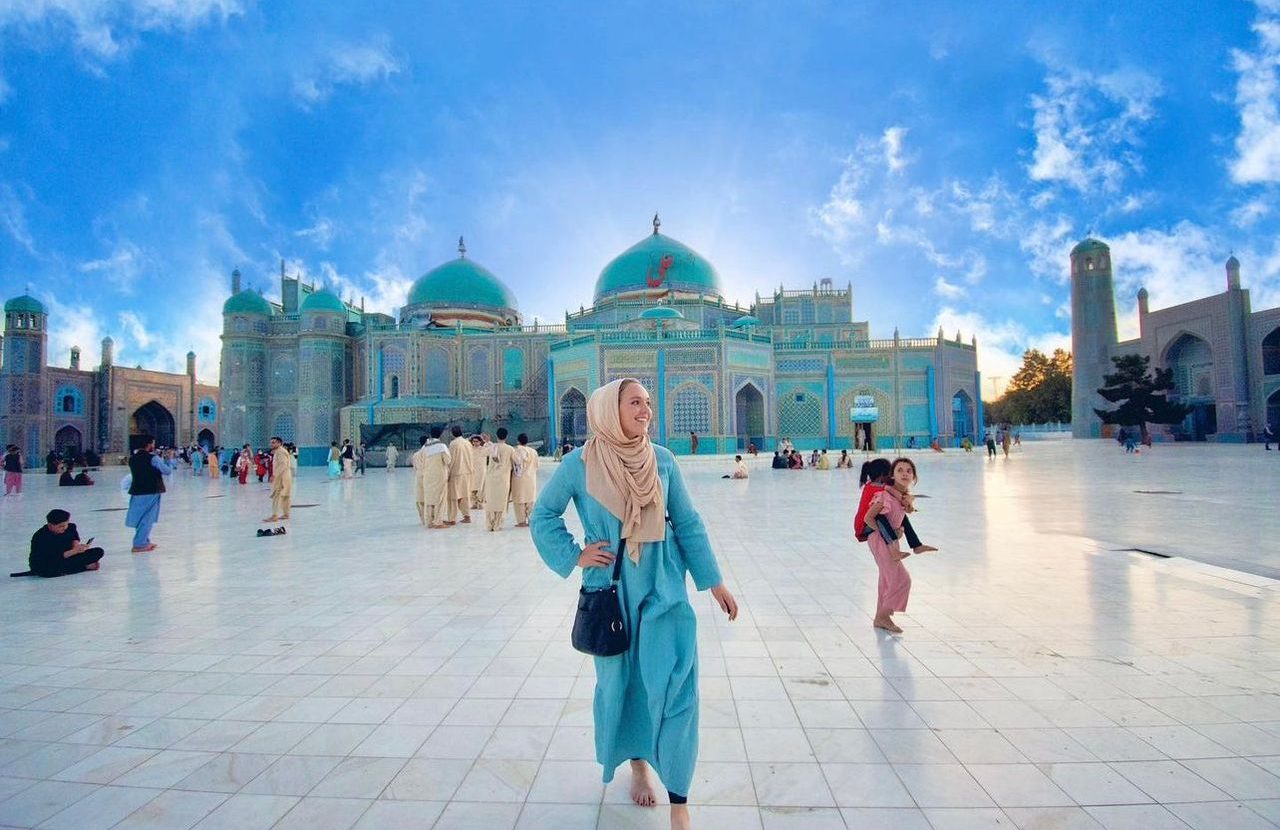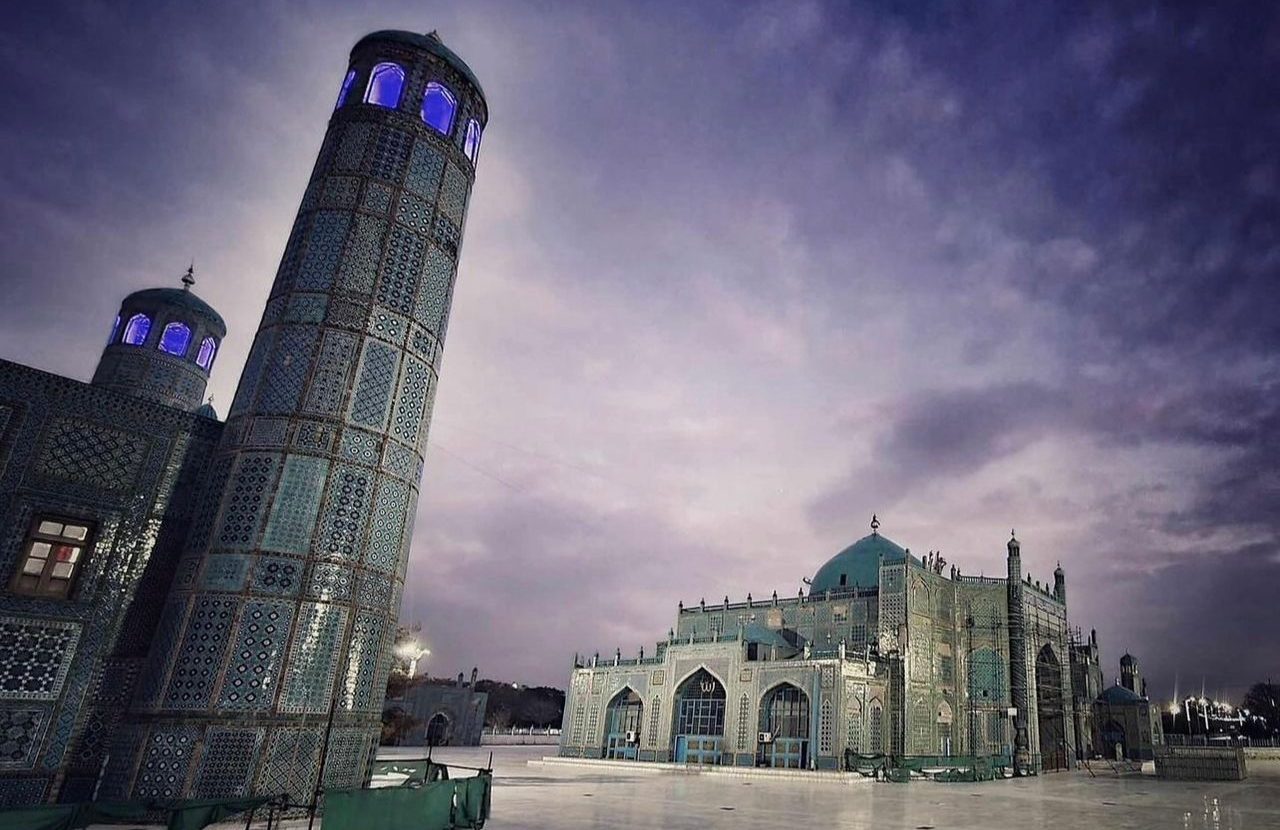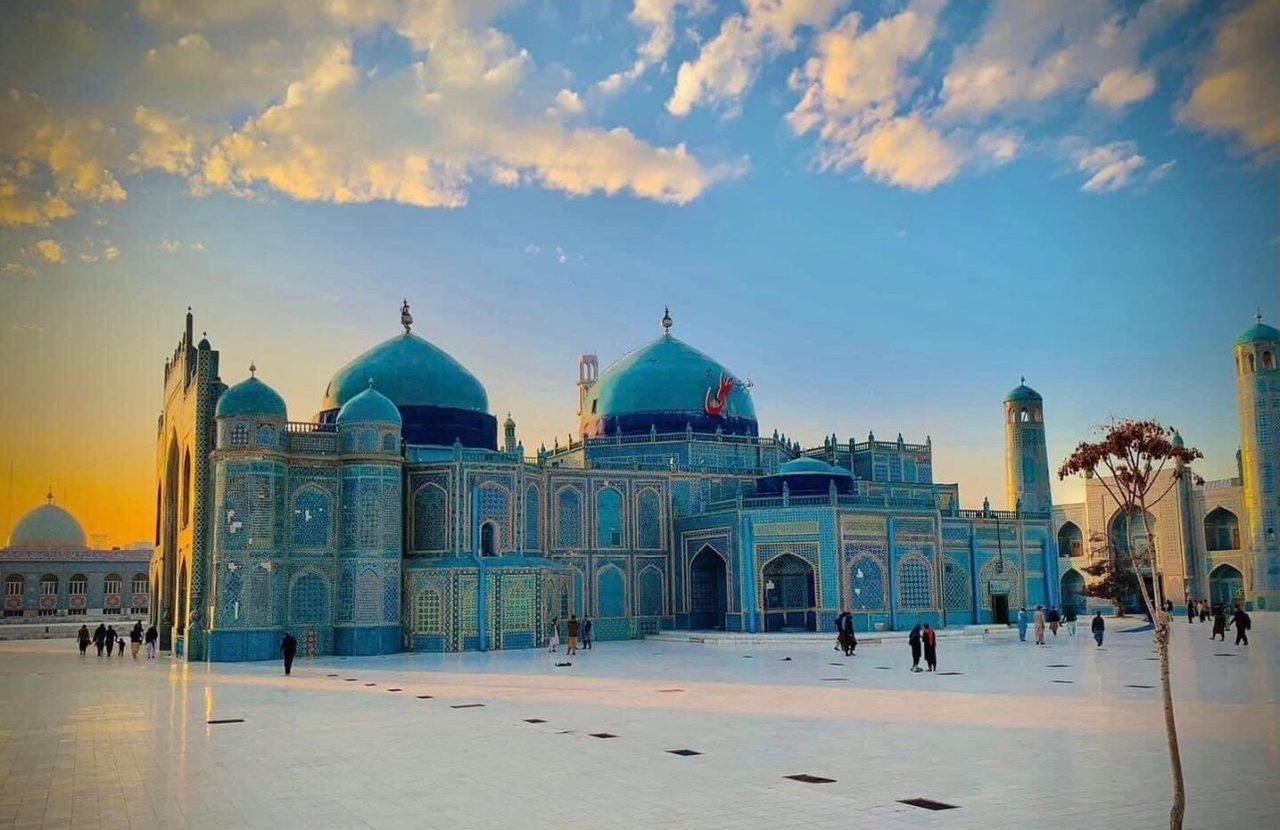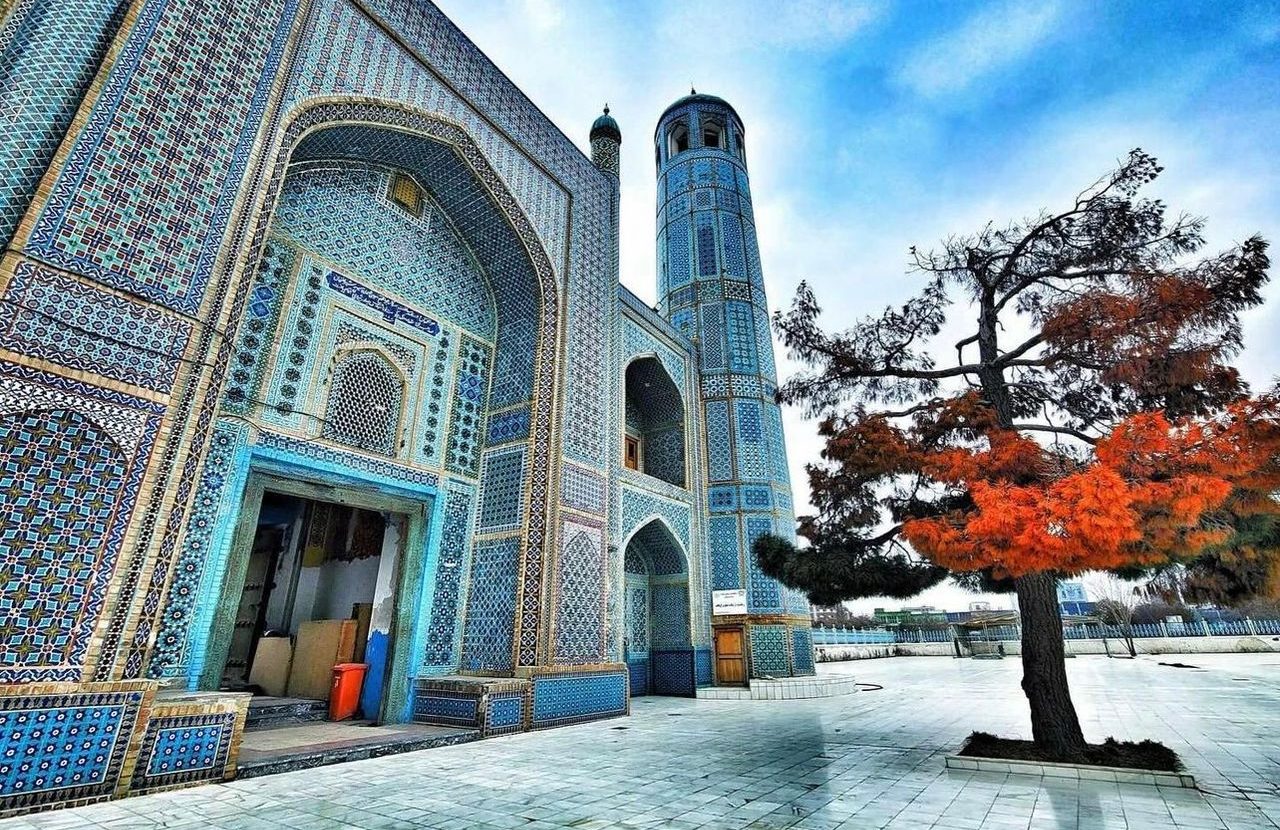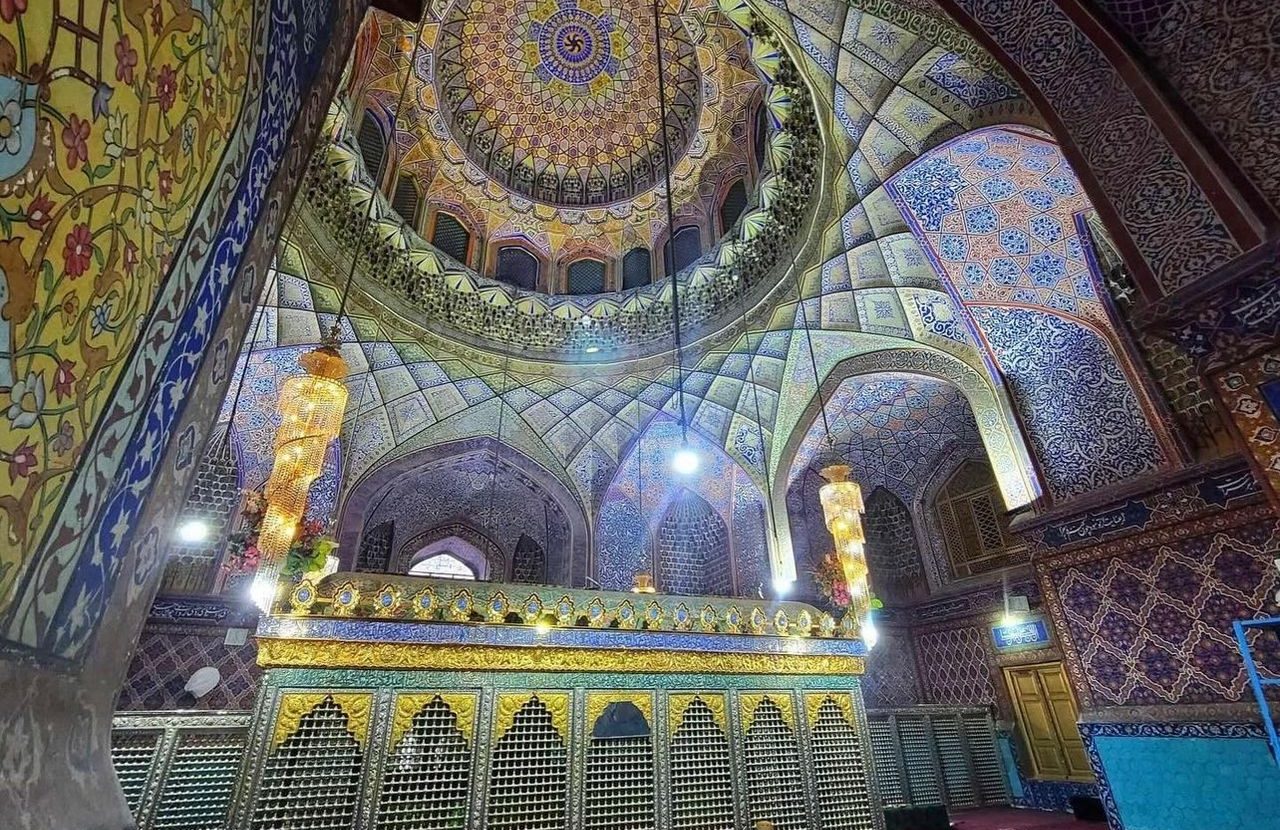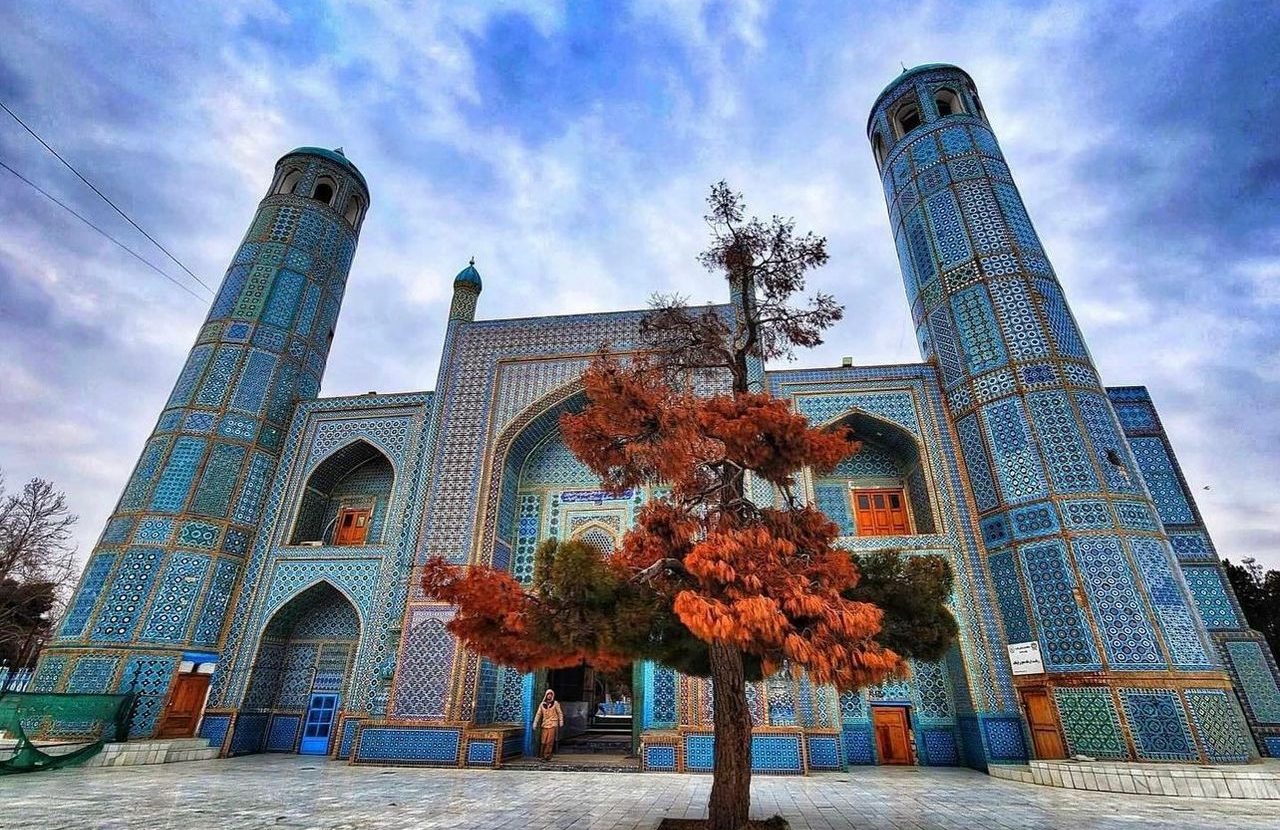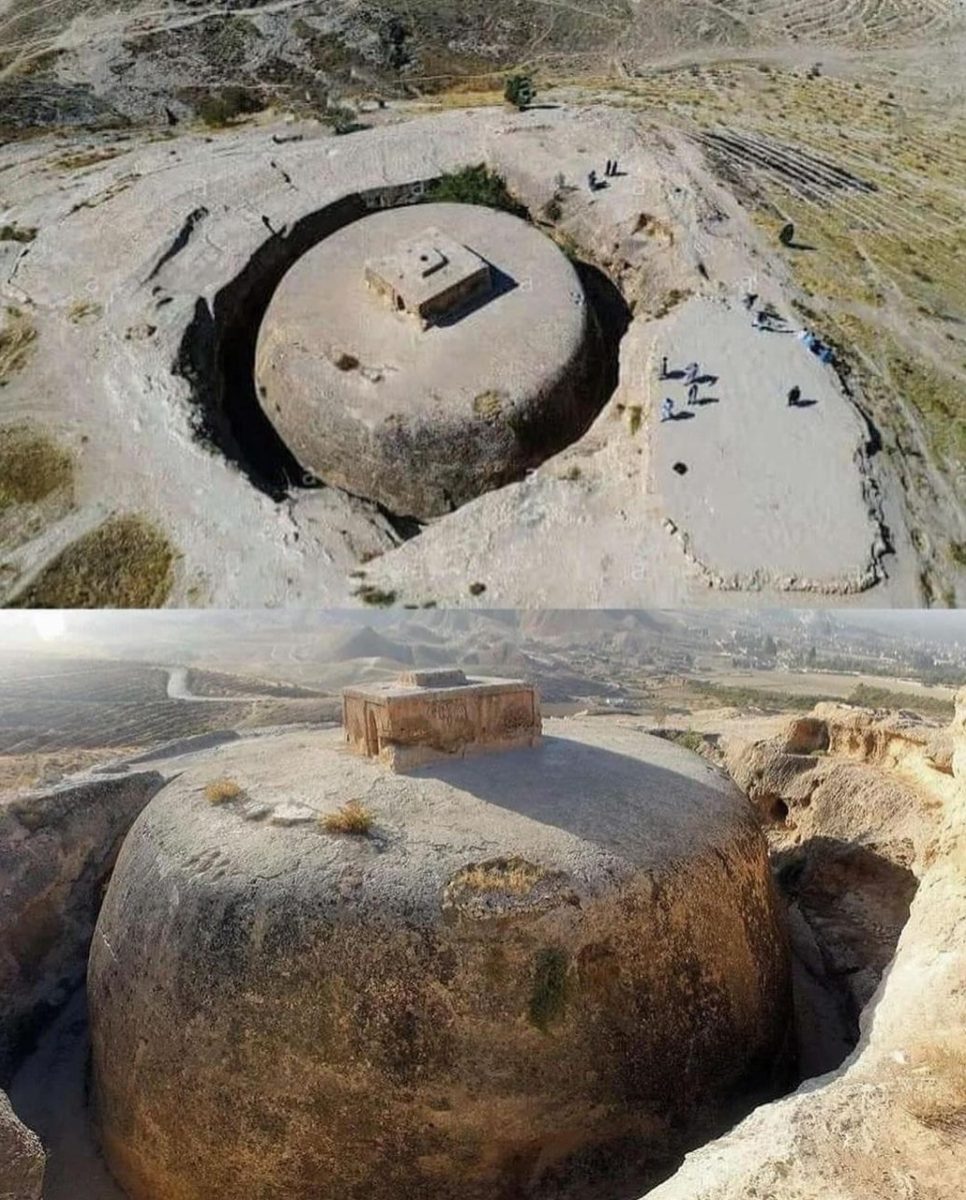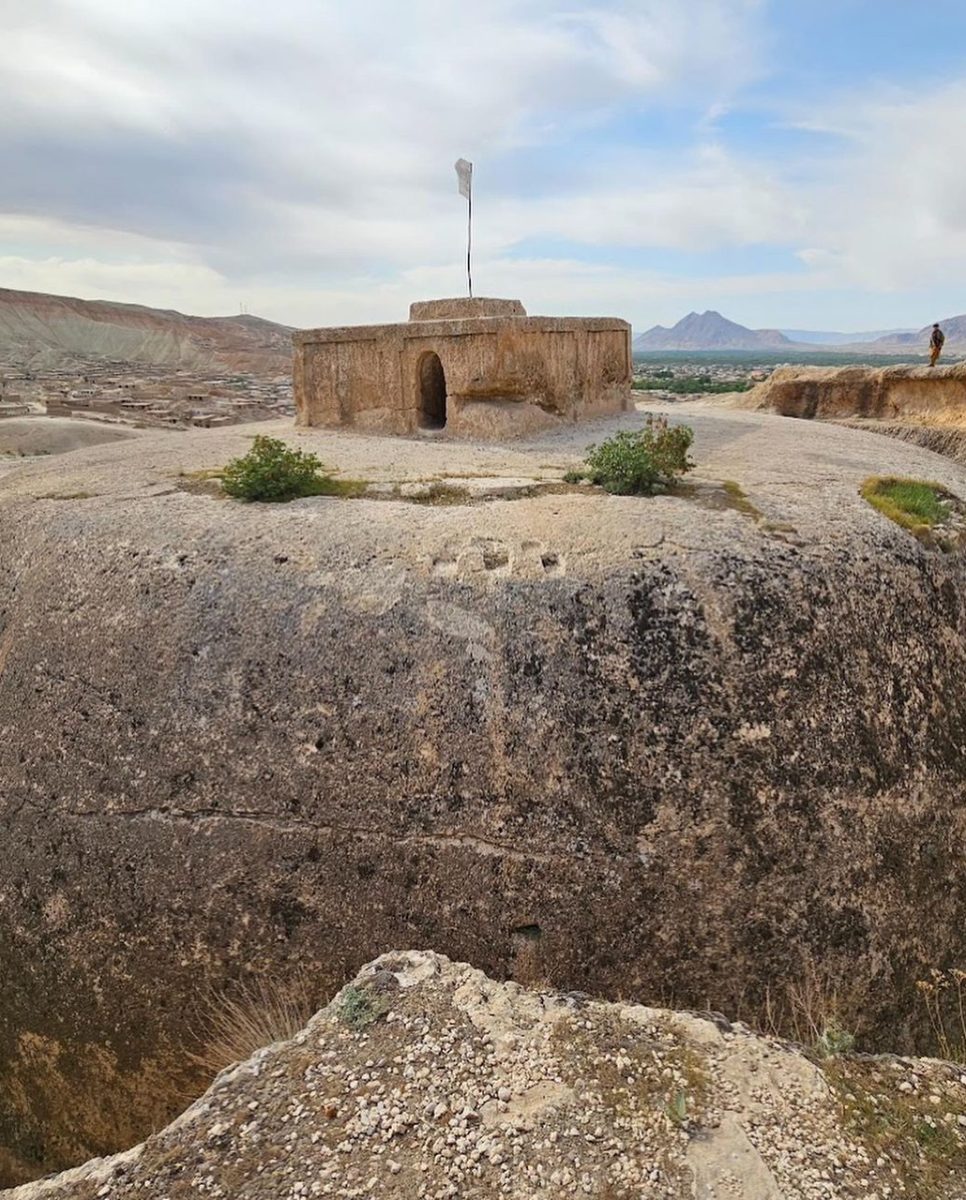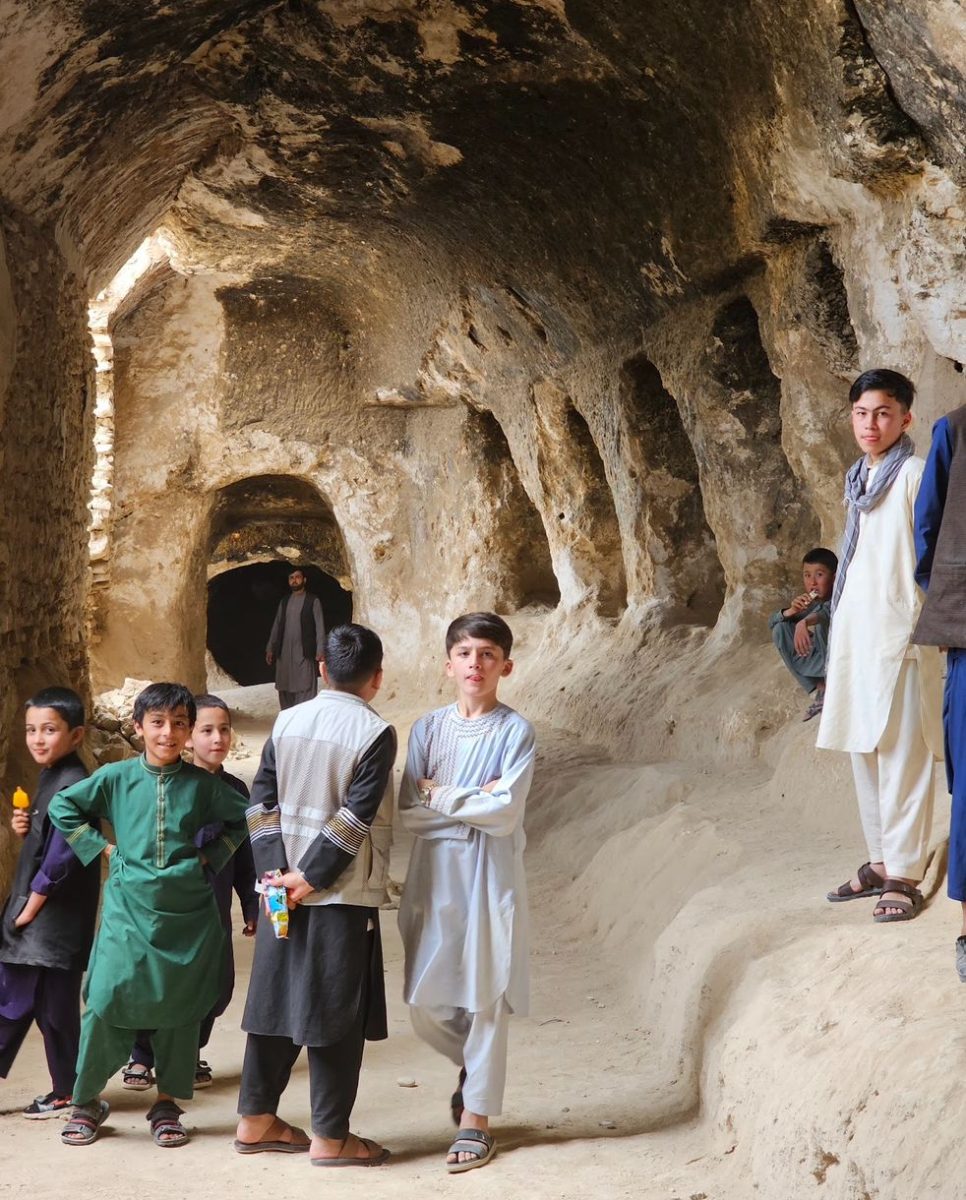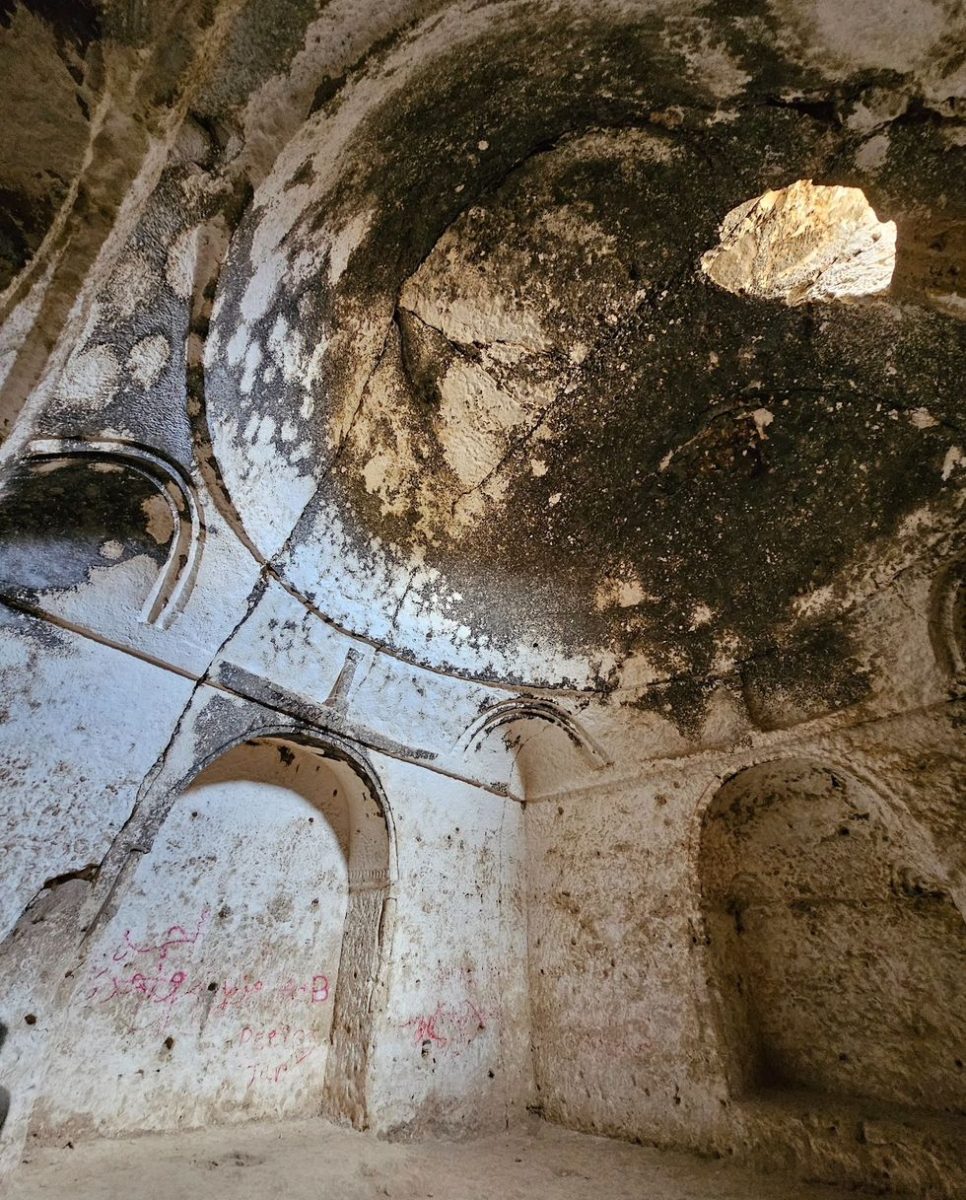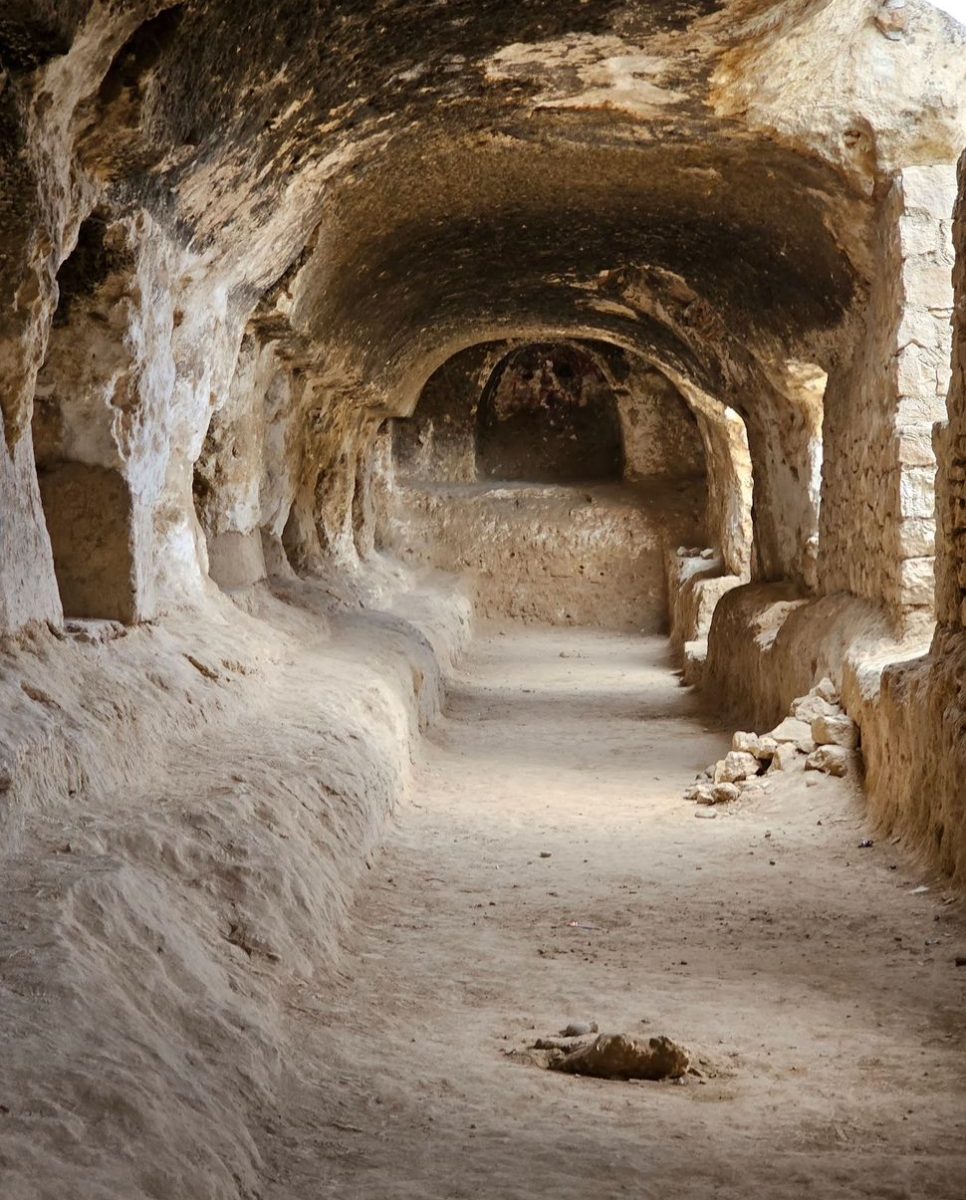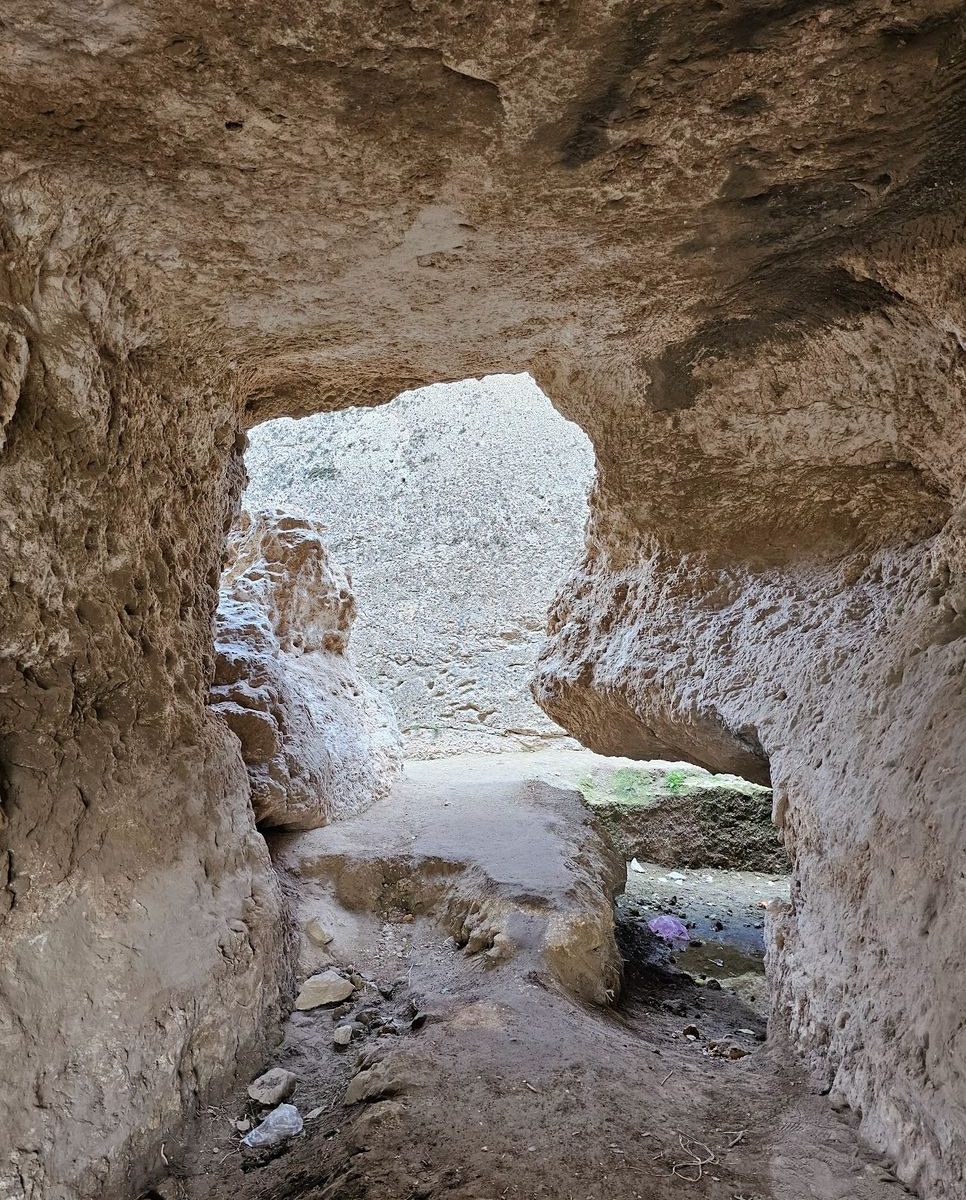Top Attractions
Check out the best places to explore in Afghanistan. From ancient monuments to deep history with natural beauty this land has to offer. Each place tells a unique story waiting to be discovered.
Mosque
1) Shah-e-Du Shamshira Mosque
The Shah-e-Du Shamshira Mosque, meaning “Mosque of the King of Two Swords,” is one of Kabul’s most iconic landmarks. Built in the early 20th century during the reign of King Amanullah Khan, it stands out for its distinctive European architectural style, which blends Islamic and Baroque influences. This two-story mosque is located near the Kabul River and the Pul-e-Khishti area in the old city of Kabul, making it a central and historical place of worship.
Key Features of Shah-e-Du Shamshira Mosque
- The mosque has a unique two-tiered structure with intricate decorations, including floral patterns and vibrant colors.
- It contrasts with the traditional Islamic architecture typically seen in Afghanistan, with its dome, windows, and arched corridors inspired by European designs.
- It is named after a legendary figure in Afghan history who fought with two swords.
- The mosque reflects the modernization efforts in Afghanistan during King Amanullah’s era.
- The mosque serves as a prominent place of worship for locals.
- It is a symbol of Kabul’s rich cultural and historical tapestry.
- Its location by the Kabul River and its distinctive design make it a must-visit site for tourists and photographers.
- The vibrant surrounding markets add to the area’s charm.
Museum
2) Kabul International Museum
The Kabul International Museum, officially known as the National Museum of Afghanistan, is a treasure trove of the country’s rich cultural and historical heritage. Located in the Darulaman area of Kabul, it is one of the most important museums in Central Asia, housing a collection that spans thousands of years of Afghan history.
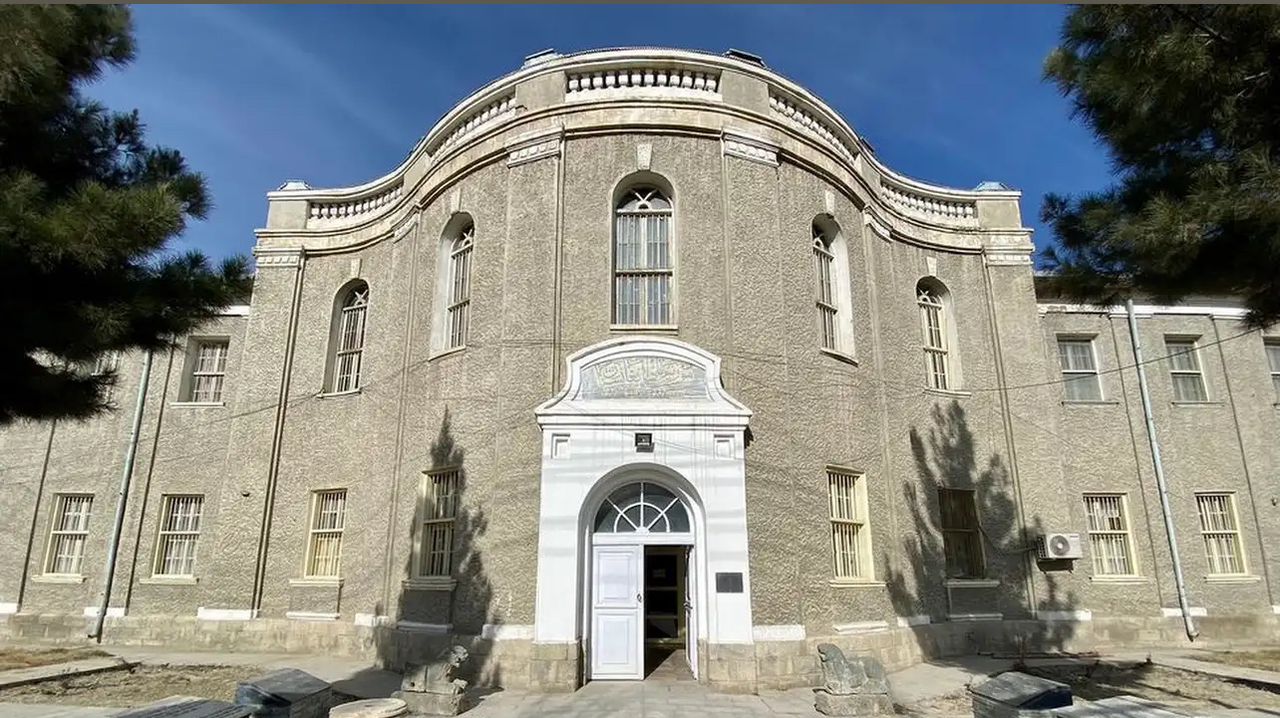
Key Highlights of the Museum
- Established in 1919, the museum was initially located in a small building near the Bagh-e-Bala Palace.
- It moved to its current location in 1931 and became internationally renowned for its extensive collection.
- Artifacts from Ancient Afghanistan: Includes objects from prehistoric times, the Greco-Bactrian era, the Kushan Empire, and the Islamic Golden Age.
- Bactrian Hoard: One of the most famous collections includes the Bactrian Gold, a stunning cache of over 20,000 gold objects from ancient burial sites.
- Gandharan Buddhist Art: Displays exquisite sculptures, manuscripts, and relics from the Gandhara civilization.
- Islamic Artifacts: Features intricate ceramics, calligraphy, and metalwork from Afghanistan’s Islamic period.
- Ethnographic Collection: Showcases traditional Afghan clothing, jewelry, and tools.
- The museum is housed in a beautiful neoclassical building with arched windows and a symmetrical design.
- Its surrounding gardens add to the serene atmosphere, making it an inviting space for visitors.
- The museum faced significant damage during decades of war, resulting in the loss of many priceless artifacts.
- Since the early 2000s, efforts have been made to restore and preserve its collections, with help from UNESCO and other international organizations.
- The museum offers guided tours in multiple languages, providing insight into Afghanistan’s diverse history.
- It also hosts temporary exhibitions, educational programs, and workshops for both locals and tourists.
Practical Information for Visitors
- Location: Darulaman Road, Kabul, Afghanistan.
- Hours: Open daily (except Fridays), typically from 9:00 AM to 4:00 PM.
- Entry Fees: Nominal charges apply, with discounts for students and groups.
- Photography: Allowed in certain areas, with prior permission.
Shrine
3) Shakhi Shrine (Sakhi Shrine)
The Shakhi Shrine, also known as Sakhi Baba Shrine, is a revered religious and historical site located in Kabul, Afghanistan. It is an important destination for both locals and visitors, offering insight into Afghanistan’s Islamic history and cultural practices. The shrine is dedicated to Hazrat Sakhi Baba, a significant Islamic saint.
Key Features of Shakhi Shrine
- Sakhi Baba is believed to be a spiritual leader who lived during the 17th century. The shrine has long been a pilgrimage site for followers of Sufism and those seeking blessings from the saint.
- The shrine is especially famous for its association with Shia Islam, as it is thought to be one of the holiest sites for Shia Muslims in Afghanistan.
- The shrine features traditional Islamic architecture with beautifully designed domes, intricate tile work, and a serene courtyard.
- The main building is an elegant structure with a large prayer hall, where visitors can offer prayers and reflect.
- Decorative elements such as colorful mosaics, calligraphy, and geometric patterns adorn the walls, adding to the spiritual ambiance.
- Pilgrimage Site: The shrine is a place of devotion, where many come to seek spiritual solace and blessings. On special days like the holy month of Muharram, large gatherings take place for prayers and rituals.
- Well of Healing: There is a well near the shrine, where it is believed that the water has healing properties. Many visitors come to drink from it or take water for loved ones who are ill.
- The shrine is a cultural hub, hosting festivals, religious events, and gatherings that strengthen the local community’s sense of identity.
- It is a place for both reflection and celebration, with local artisans and traders selling crafts and food around the shrine’s vicinity.
- The shrine is set on a hill, offering a panoramic view of Kabul and the surrounding valley, making it a peaceful retreat away from the hustle of the city.
- The serene environment, along with the frequent chants and prayers heard around the shrine, adds to the sense of tranquility and reverence that visitors experience.
Visitor Information
- Location: The Shakhi Shrine is located in the west of Kabul, near the Sakhi Hill.
- Accessibility: The site is open to visitors year-round. However, it can get crowded during major Islamic holidays, especially in Muharram.
- Opening Hours: Typically open during the day for visitors and pilgrims.
- Entry Fees: Free entry, but donations are encouraged to help maintain the shrine.
Why Visit the Shakhi Shrine?
- Historical and Cultural Significance: It provides a deep insight into the spiritual life and history of Kabul, with strong connections to both Islamic culture and the city’s history.
- A Peaceful Retreat: The shrine offers a tranquil setting, perfect for reflection, prayer, and experiencing the local culture.
- Unique Local Experience: A visit to Shakhi Shrine provides a chance to interact with local pilgrims and experience the warmth of Afghan hospitality.
Monument
4) Buddhas of Bamyan
The Buddhas of Bamyan were once among the most iconic and ancient monuments in Afghanistan. These massive statues, carved into the cliffs of the Bamyan Valley, represent the cultural and religious significance of the region, which was a center for Buddhism from the 6th to 9th centuries. Though they were tragically destroyed in 2001, the Buddhas’ historical importance remains a symbol of Afghanistan’s rich cultural heritage.
Key Features of the Buddhas of Bamyan
- The Bamyan Buddhas consisted of two colossal statues: the East Buddha (approximately 55 meters tall) and the West Buddha (around 38 meters tall). They were among the largest ancient statues in the world.
- These statues were carved from the cliffs of the Bamyan Valley in central Afghanistan, which had been a Buddhist center for centuries. The valley was a significant stop along the Silk Road, where travelers, monks, and traders exchanged goods and ideas.
- The statues represented Mahayana Buddhism, and their presence reflected Afghanistan’s historical role as a crossroads between the East and West.
- The statues were carved directly into the rock faces of the Shah-e-Zinda cliff, overlooking the Bamyan Valley. Their faces and features were highly detailed, reflecting the advanced craftsmanship of the period.
- The East Buddha was in a seated posture, while the West Buddha stood upright, thought to be a representation of the Buddha in the past or future.
- Surrounding the statues were caves and grottos, which housed Buddhist monasteries and served as places for meditation and pilgrimage. Frescoes and inscriptions also adorned the area, showcasing a blend of Indian, Central Asian, and Buddhist art traditions.
- In March 2001, the Taliban destroyed the Buddhas, citing their destruction of pre-Islamic artifacts as part of their interpretation of Islamic doctrine. The statues were dynamited, leaving only their outlines and the surrounding niches in the cliffs.
- Since then, there have been various efforts to preserve the site and restore the cultural memory of the Buddhas. International organizations, including UNESCO, have worked to protect and conserve the area, with plans for reconstruction and documentation.
- The Bamyan Valley itself is a UNESCO World Heritage site, celebrated for its stunning landscape, ancient caves, and historical significance. The valley is home to various Buddhist relics, including frescoes, carved inscriptions, and man-made caves.
- Visitors can see the remnants of the Buddhas, and it is considered a symbol of cultural resilience, representing Afghanistan’s rich Buddhist past before the arrival of Islam.
- Despite the destruction of the Buddhas, they continue to hold deep cultural and spiritual meaning for both the people of Afghanistan and global communities. The Bamyan site remains a symbol of the nation’s diverse history, welcoming visitors from around the world who wish to learn more about Afghanistan’s historical significance on the world stage.
- Many locals still revere the Bamyan Valley as a sacred site, and it remains an important destination for those interested in the history of Buddhism in Afghanistan.
Visitor Information
- Location: The Buddhas of Bamyan are located in the Bamyan Valley, about 240 kilometers northwest of Kabul, Afghanistan.
- Access: The site is accessible by road, and while the journey may take several hours, the scenic views along the way make it a rewarding trip.
- Hours: The site is open year-round, though access may be limited during winter due to weather conditions.
- Entry Fees: There may be a nominal fee for entry to the site, but tourists can also book guided tours that offer more in-depth information about the site’s history and significance.
Why Visit the Buddhas of Bamyan?
- Historical Significance: The Buddhas of Bamyan are a testament to Afghanistan’s ancient Buddhist heritage and role as a cultural and religious crossroads.
- Cultural Reflection: Visiting the site provides insight into the deep history of the Bamyan Valley, with remnants of art, architecture, and religious traditions from the past.
- Scenic Beauty: The site is surrounded by the breathtaking landscape of the Bamyan Valley, with towering cliffs and expansive views that add to the spiritual atmosphere of the place.
- Resilience and Preservation: Despite the destruction, the area remains a symbol of cultural resilience, and visiting it supports efforts to preserve Afghanistan’s rich history for future generations.
Stupa
5) Shiwaky Stupa (Shiwaki Stupa)
The Shiwaky Stupa is a significant archaeological and historical site located in the Kabul Valley, Afghanistan. It is one of the ancient Buddhist stupas that offer a glimpse into Afghanistan’s rich history before the arrival of Islam. Though less well-known than the famous Bamyan Buddhas, the Shiwaky Stupa holds an important place in understanding the spread of Buddhism in the region and its cultural influences.
Key Features of the Shiwaky Stupa
- The Shiwaky Stupa is believed to date back to the 3rd or 4th century CE, during the Kushan Empire period, a time when Afghanistan was an important center for Buddhist culture.
- The stupa is associated with the spread of Mahayana Buddhism and was likely a place for both meditation and rituals. It highlights the influence of Indian and Central Asian Buddhism on the region.
- The stupa and its surrounding area were significant not only for religious purposes but also as part of the Silk Road, where cultures, religions, and ideas intersected.
- The stupa, like many Buddhist stupas, was originally a mound-shaped structure used to house relics of Buddhist saints or monks.
- Over time, it has been damaged, but remnants of its original structure can still be seen today. The site consists of stone ruins and inscriptions that indicate its historical importance.
- The stupa’s surroundings contain small shrines and carved stone pillars, some of which feature Buddhist iconography, such as depictions of the Buddha and various Bodhisattvas.
- The Shiwaky Stupa, like many ancient sites in Afghanistan, has faced damage due to conflict and neglect over the years.
- Archaeologists and historians have made efforts to excavate and preserve the site, although much of the stupa’s former grandeur has been lost. Still, ongoing research and preservation initiatives continue to reveal more about its history.
- The stupa is a testament to the rich Buddhist heritage of Afghanistan, and efforts to restore and protect such sites are ongoing.
- The stupa is located near other Buddhist ruins, caves, and monasteries, many of which are in the Kabul Valley. These sites are rich in historical and religious significance.
- The area around the Shiwaky Stupa also contains evidence of ancient carvings and mural paintings that offer additional insight into the spread of Buddhism across Afghanistan.
- The Shiwaky Stupa is not as well-known or as visited as other major sites like the Bamyan Buddhas. However, it remains an important stop for those interested in Afghanistan’s Buddhist past and archaeological sites.
- The stupa’s location in the Kabul Valley makes it a part of the region’s larger historical and archaeological landscape, offering a unique opportunity to explore the ancient history of Afghanistan.
Visitor Information
- Location: The Shiwaky Stupa is located in the Kabul Valley, near the Shiwaky region, a short drive from central Kabul.
- Accessibility: Visitors can access the stupa via road from Kabul, though it may require some local knowledge to navigate.
- Hours: The site is open year-round, but visitors may need to make prior arrangements for tours or guide services to understand its historical context.
- Entry Fees: While the site is generally open to the public, there may be a small entry fee or donations for maintenance and preservation.
Why Visit the Shiwaky Stupa?
- Cultural Heritage: The Shiwaky Stupa is an important piece of Afghanistan’s Buddhist past and offers insight into the region’s role in the spread of Buddhism.
- Archaeological Significance: For history enthusiasts and archaeologists, visiting the site provides a rare opportunity to explore one of Afghanistan’s lesser-known ancient sites.
- Spiritual Reflection: As with many Buddhist stupas, the Shiwaky Stupa offers a peaceful environment for reflection and contemplation amidst the ruins of a once-grand religious structure.
Market
6) Kabul Birds Street
Kabul Birds Street is a unique and vibrant market in the heart of Kabul, Afghanistan. Known locally as “Shahr-e-Kuhna,” this street is famous for its wide array of caged birds and the lively atmosphere that surrounds it. The street offers visitors a glimpse into Afghan culture, where birds are not only pets but hold symbolic meaning in Afghan society. It’s a must-visit spot for those looking to experience the local traditions, commerce, and the passion Afghan people have for birds.
Key Features of Kabul Birds Street
- Kabul Birds Street is a renowned marketplace where local vendors sell various species of birds, including parrots, doves, canaries, pigeons, and quails.
- The market is a popular destination for both bird enthusiasts and tourists who want to experience the unique bird culture of Kabul.
- Bird vendors often offer their knowledge about each species and may even sell birds along with their cages, food, and accessories.
- In Afghan culture, birds have been cherished for centuries. Owning birds is seen as a symbol of wealth, status, and affection. Birds are often considered companions and are believed to bring good luck to their owners.
- The tradition of birdkeeping in Afghanistan is part of a wider cultural heritage that blends local customs and Islamic influences.
- Kabul’s Birds Street is also a reflection of the city’s lively market culture and social interaction, where people come together to share their love for animals and the outdoors.
- The street is always bustling with activity. Visitors can see vendors displaying their colorful birds in cages, their songs filling the air. The atmosphere is festive, with the chatter of merchants and the chirping of birds creating a unique blend of sounds.
- The narrow alleys of the Birds Street are lined with stalls, many adorned with bird-related products, including food, toys, and cages.
- It’s not just about selling birds—many people come to simply enjoy the atmosphere and observe the birds in their cages, experiencing a sense of tranquility in the midst of the busy market.
- Visitors to Kabul Birds Street will find the market a place where locals are friendly and eager to share their knowledge of the birds they are selling. The exchange between vendors and customers often goes beyond business, with many sharing stories and experiences about bird keeping.
- Bird ownership is a family affair for many, and older generations often pass down the tradition of bird-keeping to younger ones.
- With its vibrant displays of colorful birds, Kabul Birds Street is a photographer’s paradise. The vivid feathers of the birds, along with the busy street scenes, offer opportunities for stunning visual captures.
- The lively market, with its caged birds and local vendors, is an excellent spot for tourists to take unique photos that reflect the spirit of Kabul.
Visitor Information
- Location: Kabul Birds Street is located in the old part of Kabul, near the Kabul City Center. It’s easily accessible by foot from other major landmarks in Kabul.
- Opening Hours: The market is generally open every day of the week, with the most activity typically during morning and afternoon hours.
- Best Time to Visit: Early morning is the best time to visit, as the vendors are setting up their stalls, and the street is less crowded, giving visitors an opportunity to interact with the vendors.
- Entry Fees: There is no entry fee to visit the Birds Street, but purchasing or bargaining for birds and products is the main activity.
Why Visit Kabul Birds Street?
- Cultural Experience: Visiting Kabul Birds Street provides a unique opportunity to experience an important aspect of Afghan culture—bird-keeping—and interact with local vendors and enthusiasts.
- Vibrant Atmosphere: The lively, colorful environment of the market makes for a fun and memorable experience, whether you are buying birds or simply enjoying the spectacle.
- Ideal for Photography: The street offers wonderful photography opportunities for those interested in capturing Kabul’s local life, with colorful birds and market scenes that highlight Afghan traditions.
City
7) Gholghola City (City of Screams) - Bamyan
Gholghola, often referred to as the City of Screams, is an ancient and historically significant site located in the Bamyan Valley of Afghanistan. The name “Gholghola” translates to “city of screams,” which is believed to be linked to the horrific massacre that occurred there during the Mongol invasion in the 13th century. Today, Gholghola stands as a powerful symbol of Afghanistan’s turbulent history, and its archaeological remains offer insights into the country’s cultural and historical past.
Key Features of Gholghola City
- Gholghola was once a thriving city in the Bamyan Valley and played an important role in the Buddhist culture of the region. It is believed to have been established as early as the 1st century CE during the Kushan Empire and flourished for centuries.
- The city’s downfall is linked to the Mongol invasion led by Genghis Khan in the 13th century. The Mongols destroyed the city, and it is said that the screams of its inhabitants could be heard for miles, which is why the city came to be known as the “City of Screams.”
- According to historical accounts, after Genghis Khan’s forces took the city, they massacred the population. It is said that the Mongols used brutal tactics and mass executions to subdue the inhabitants, and the screams of the victims echoed through the valley.
- The tragic event is a significant part of Afghanistan’s history, marking the Mongol empire’s destruction of many cities along the Silk Road.
- Today, the site of Gholghola is an archaeological treasure, with ruins and artifacts scattered throughout the area. The city’s remains include fortifications, residential areas, temples, and Buddhist statues.
- Many of the ruins are located on a hilltop, providing a panoramic view of the surrounding Bamyan Valley. The site is a place for archaeologists and historians to study the early Buddhist civilization in Afghanistan.
- The ancient structures at Gholghola give clues to the city’s once-thriving community and its connections to the Silk Road trade routes.
- As part of the Bamyan Valley, Gholghola shares the cultural and religious heritage of the area. The Bamyan Valley was a key center for Buddhism, and Gholghola likely played a role in the region’s religious and cultural exchanges.
- Buddhist statues and artifacts found at Gholghola suggest that the city was an important site for Buddhist monasteries and spiritual gatherings, just like the nearby Bamyan Buddhas.
- Today, Gholghola is a quiet and haunting reminder of Afghanistan’s ancient past. Though it remains largely uninhabited, the site continues to attract tourists, historians, and archaeologists who come to explore its history.
- Gholghola is part of the broader Bamyan Valley, which is a UNESCO World Heritage Site and renowned for its cultural significance and stunning landscapes.
Visitor Information
- Location: Gholghola is located in the Bamyan Valley, approximately 30 kilometers east of the town of Bamyan. It’s situated near the famous Bamyan Buddhas.
- Access: The site can be visited by road, either by private transportation or with a guide. The journey takes visitors through the Bamyan Valley, offering scenic views of the rugged terrain.
- Best Time to Visit: The best time to visit Gholghola is during the spring and summer months (April to October), when the weather is milder and the valley is in full bloom.
- Entry Fees: There may be a small fee for entry to the site, especially if a local guide is involved. This fee typically goes towards maintaining the site.
Why Visit Gholghola City?
- Historical Significance: Visiting Gholghola allows you to connect with Afghanistan’s ancient past, including the Buddhist heritage and the dramatic history of the Mongol invasion.
- Archaeological Interest: The ruins and archaeological findings at Gholghola are invaluable for understanding Afghanistan’s role in the broader Silk Road network and its rich cultural heritage.
- Cultural Reflection: Gholghola offers a poignant experience for visitors to reflect on the country’s resilience, both in the face of ancient destruction and modern conflict.
- Stunning Views: The site is located on a hill, offering breathtaking views of the Bamyan Valley and its surrounding landscape, making it a perfect spot for photography and exploration.
Why Gholghola is Special?
City
8) Zuhak City
Zuhak, also known as Zohak, is an ancient archaeological site in Afghanistan, located in the eastern part of the country. The city has significant historical and cultural value, offering insights into the ancient civilizations that once thrived in the region. Though it is less known than other sites like Bamyan or Gholghola, Zuhak has a rich history and offers a glimpse into the early urban development in Afghanistan.
Key Features of Zuhak City
- Zuhak is believed to have been a fortified city or stronghold dating back to ancient times, possibly from the Persian Empire or earlier periods. It is thought to have been part of the Silk Road network, serving as a trade hub connecting the east and west.
- The site is also tied to Persian mythology, where Zuhak is mentioned as the name of a legendary king in ancient Persian texts, most notably in the Shahnameh, the great Persian epic. In mythology, Zuhak was a ruler cursed by the gods to have snakes grow from his shoulders, which would eat his brain. While the city itself is not directly tied to this myth, the name has cultural resonance in the region.
- The site is known for its ruins, which include remnants of ancient structures, walls, and fortifications that suggest the city’s once-thriving status. The ruins offer important clues about ancient urban life in Afghanistan.
- Excavations in the area have uncovered various artifacts, including pottery, tools, and coins, which help date the site and provide insights into the culture and economy of the region.
- There is evidence of Iranian, Indian, and Central Asian cultural influences in the artifacts found at Zuhak, highlighting its role in the cross-cultural exchanges that took place along the Silk Road.
- Zuhak is situated in a strategically important area, with natural defenses such as mountains and rivers surrounding the city. This would have made it a valuable location for ancient civilizations looking to control trade routes and defend against invasions.
- Its proximity to modern-day regions such as Paktia and Khost in Afghanistan, as well as the border with Pakistan, further adds to its historical importance as a gateway between different regions of the ancient world.
- While the city of Zuhak itself has been lost to time, it is a reflection of Afghanistan’s ancient urban culture, with connections to the Indo-Iranian traditions. The ruins at Zuhak help paint a picture of the cultural and architectural styles that once characterized the region.
- The mythological aspect of Zuhak also ties the site to larger cultural traditions in the area, with many places in Afghanistan and Iran sharing similar stories from ancient texts.
- The site of Zuhak is not as well-known as other major Afghan historical sites, and it remains relatively under-explored. It faces significant challenges in terms of preservation due to the region’s instability and lack of resources for archaeological studies.
- Despite this, the site still attracts interest from archaeologists and historians eager to explore Afghanistan’s ancient civilizations and mythological heritage.
Visitor Information
- Location: Zuhak is located in eastern Afghanistan, near Paktia and Khost provinces. The site can be reached by road, though it may require a local guide for navigating the area.
- Access: Visitors will need to arrange transport, as the site is not widely visited by tourists. It’s best to check for any travel advisories or region-specific requirements.
- Best Time to Visit: The best time to visit is during the spring and fall (April to October), when the weather is milder and the region is more accessible.
- Entry Fees: As the site is relatively underdeveloped for tourism, there may not be formal entry fees, though a local guide or permission from regional authorities might be necessary.
Why Visit Zuhak City?
- Historical Exploration: Zuhak is a lesser-known historical site that offers an opportunity to explore the ancient urban culture of Afghanistan and understand the country’s role in the Silk Road and ancient civilizations.
- Cultural and Mythological Connection: For those interested in ancient Persian mythology and the larger cultural context of Zoroastrianism and Persian epics, Zuhak offers an interesting connection to the Shahnameh and the legendary figure of King Zuhak.
- Off-the-Beaten-Path Destination: For adventurous travelers and history enthusiasts, Zuhak provides a chance to visit an ancient site that few tourists have explored, offering a sense of discovery and connection to Afghanistan’s deep past.
Why Zuhak is Special?
Valley
9) Dragon Valley (Gorge of Dragons) - Afghanistan
Dragon Valley, also known as Gorge of Dragons, is a mysterious and mythic location in Afghanistan. The name “Dragon Valley” is tied to both local legends and geological features that have made this place a source of fascination for explorers, historians, and locals alike. Though not widely known internationally, Dragon Valley holds cultural and mythological significance for the people of Afghanistan.
Key Features of Dragon Valley
- Dragon Valley is named after ancient local myths that tell stories of dragons or giant serpent-like creatures that once inhabited the area. These myths often reflect ancient beliefs in monstrous beings that were said to guard treasures or wreak havoc on human settlements.
- In Afghan folklore, dragons are seen as symbols of power, danger, and sometimes even protection. In some accounts, these creatures were thought to have magical powers or the ability to control elements like fire or water.
- The landscape of Dragon Valley is both awe-inspiring and unique, with steep cliffs, rocky formations, and deep ravines that could have inspired local legends of dragons. The natural terrain is rugged and difficult, contributing to the mystique of the area.
- Some visitors report seeing shapes in the rock formations that resemble dragon-like creatures, further fueling the connection between the valley and local folklore.
- Dragon Valley is believed to be located in eastern Afghanistan, though the exact location is often debated, with various sources mentioning different parts of the country, including areas near the Pamir Mountains and Kunar province.
- The valley’s myths and natural features align with Afghanistan’s broader cultural traditions that often involve supernatural creatures and spiritual stories passed down through generations.
- Beyond its mythological appeal, Dragon Valley is known for its stunning natural beauty. The valley is often surrounded by lush vegetation, flowing rivers, and wildlife, making it a prime location for nature lovers and adventurers looking to explore the rugged landscapes of Afghanistan.
- The region’s isolated and untouched nature makes it a great place for those who seek solitude and the opportunity to experience Afghanistan’s natural beauty in its purest form.
- For adventurous travelers, Dragon Valley presents an exciting off-the-beaten-path destination, with opportunities for trekking, hiking, and photography. The dramatic landscapes and remote location make it a perfect destination for those interested in outdoor exploration and discovery.
- Cultural exchange with local communities is also possible, as many locals still hold onto traditional beliefs about the valley and its mysterious past.
Visitor Information
- Location: Dragon Valley is located in eastern Afghanistan, with the exact location often varying in sources. It is generally believed to be found in the vicinity of the Pamir Mountains or Kunar province, though some accounts place it in the Badakhshan or Nuristan regions.
- Access: The valley is remote and difficult to access, requiring travelers to plan their journey with a local guide and possibly obtain permits depending on the security situation in the region. It is advised to check for any travel advisories or regional restrictions.
- Best Time to Visit: The best time to visit Dragon Valley is during the spring and summer months (April to October), when the weather is milder, and the landscape is more accessible.
- Entry Fees: As a relatively unknown and mystical location, there may be no formal entry fees. However, visitors should expect to hire a local guide for the trek and ensure proper permissions to visit the area.
Why Visit Dragon Valley?
- Mythological Adventure: Dragon Valley is a fascinating destination for anyone interested in ancient legends and supernatural folklore. The valley’s rich cultural history, combined with its natural beauty, makes it an intriguing place to explore.
- Scenic Beauty: For those who love rugged landscapes and pristine natural environments, Dragon Valley offers one of Afghanistan’s most stunning vistas, with its rocky cliffs, lush vegetation, and wildlife.
- Off-the-Beaten-Path: This remote location appeals to travelers looking for a unique, adventurous experience away from well-trodden tourist paths. Its mysterious name and the folklore surrounding it make it a memorable destination.
- Cultural Immersion: Dragon Valley offers the chance to experience the local Afghan culture, with insights into the myths and legends that shape the worldview of communities in the region.
Why Dragon Valley is Special?
National Park
10) Band-e-Amir National Park
Band-e-Amir National Park is Afghanistan’s first designated national park and one of its most iconic natural landmarks. Located in the Hindu Kush Mountains of Bamyan Province, this stunning park is home to six interconnected lakes known for their brilliant blue waters and breathtaking landscapes. These natural wonders attract tourists, locals, and nature enthusiasts from across the country and around the world.
Highlights of Band-e-Amir
- Band-e-Amir comprises six magnificent lakes:
1. Band-e-Haibat (“Lake of Awe”)
2. Band-e-Zulfiqar
3. Band-e-Panir (“Cheese Lake”)
4. Band-e-Pudina (“Mint Lake”)
5. Band-e-Gholaman (“Slave Lake”)
6. Band-e-Kahta (“Small Lake”) - These lakes are separated by natural travertine dams, a rare geological feature formed by calcium deposits over thousands of years.
- The lakes are renowned for their vivid blue and turquoise hues, which result from sunlight reflecting off minerals in the water.
- The striking contrast of the clear waters against the surrounding red and beige cliffs makes Band-e-Amir a photographer’s paradise.
- According to local legend, the lakes were miraculously created by Hazrat Ali, the fourth Caliph of Islam, who used his divine power to form the travertine dams.
- Band-e-Amir is considered a sacred site, and many visitors come here to pray, seek blessings, and enjoy the tranquil atmosphere.
- Band-e-Amir was declared Afghanistan’s first national park in 2009, with support from the UN Environment Programme (UNEP).
- The park’s designation aims to protect its unique geology, biodiversity, and cultural heritage while promoting eco-tourism.
- The park is home to a variety of wildlife, including ibex, snow leopards, and various bird species such as herons and wild ducks.
- Its remote location and pristine environment make it a key area for conserving Afghanistan’s natural biodiversity.
Visitor Information
- Location: Band-e-Amir is situated approximately 75 kilometers west of Bamyan City in central Afghanistan.
- Transportation: Visitors can travel to Bamyan City by road or air from Kabul and then continue to Band-e-Amir by car or private transport. Hiring a local guide or joining a tour group is recommended for convenience and safety.
- Best Time to Visit: The ideal time to visit is from April to October, when the weather is mild, and the lakes are at their most vibrant. During the winter, the area is often covered in snow, which may limit accessibility.
- Activities:
1. Boating: Explore the serene waters in a small boat, available for rent near the lakes.
2. Hiking: Discover the park’s scenic trails and enjoy panoramic views of the surrounding mountains.
3. Photography: Capture the vivid blues of the lakes and the rugged cliffs that frame them.
4. Picnicking: Relax along the lake shores and enjoy the peaceful environment.
Why Visit Band-e-Amir?
- Natural Beauty: The vibrant blue waters, surrounded by dramatic cliffs, make Band-e-Amir one of the world’s most beautiful natural sites.
- Cultural Significance: The park offers a unique blend of Afghanistan’s cultural, religious, and natural heritage.
- Eco-Tourism Destination: Band-e-Amir provides a rare opportunity to experience Afghanistan’s unspoiled wilderness and biodiversity.
- Tranquility: Far from the bustling cities, the serene atmosphere of Band-e-Amir is perfect for relaxation and introspection.
What Makes Band-e-Amir Unique?
Tower
11) Minaret of Jam
The Minaret of Jam, located in the remote Ghor Province of Afghanistan, is one of the country’s most important historical and architectural landmarks. Built in the 12th century, this UNESCO World Heritage Site is a towering testament to the skill and artistry of the Ghurid Empire. Standing at approximately 65 meters (213 feet), it is the second-tallest brick minaret in the world and is celebrated for its intricate decorations and historical significance.
Highlights of the Minaret of Jam
- The Minaret of Jam was constructed around 1190 AD during the height of the Ghurid Empire.
- It is believed to have been part of the ancient city of Firuzkuh, the lost capital of the Ghurids, which flourished as a cultural and political hub.
- Its location near the confluence of the Hari Rud and Jam Rud rivers suggests its importance as a marker on trade and pilgrimage routes.
- The minaret is made of fired bricks and is richly decorated with geometric patterns, verses from the Quran, and Kufic and Naskh calligraphy.
- Its slender, octagonal shaft rests on a two-tiered base and features intricate carvings and glazed tiles.
- Despite centuries of exposure to natural elements, its artistic details remain remarkably well-preserved.
- The Minaret of Jam was designated a UNESCO World Heritage Site in 2002 due to its architectural significance and vulnerability.
- It is also on UNESCO’s list of World Heritage in Danger, facing threats from erosion, flooding, and lack of preservation.
- The minaret symbolizes the Ghurid Dynasty’s contribution to Islamic art and architecture, blending local and Persian influences.
- Its design likely influenced later Islamic minarets, including those in Delhi built by the Ghurid successors.
- The minaret is set in a dramatic landscape of rugged mountains and river valleys, adding to its allure.
- Archaeological evidence in the area suggests the presence of a bustling medieval city, including fortifications, pottery, and other remnants of Ghurid civilization.
Visitor Information
- Location: The Minaret of Jam is located in the Shahrak District of Ghor Province, about 200 kilometers east of Herat.
- Accessibility:
1. The site is remote and requires careful planning to visit. A four-wheel-drive vehicle is recommended due to rough terrain.
2. Travelers are advised to hire local guides for navigation and safety. - Best Time to Visit: The best months to visit are April to October, when weather conditions are favorable.
- Tourist Activities:
1. Exploration: Visitors can walk around the minaret and explore the surrounding ruins of Firuzkuh.
2. Photography: The intricate designs of the minaret and the stunning natural surroundings offer incredible photography opportunities.
3. Cultural Insight: Learn about the history of the Ghurid Empire and the architectural innovations of the medieval Islamic world.
Why Visit the Minaret of Jam?
- Historical Importance: It is a rare surviving structure from the Ghurid Empire, offering a glimpse into Afghanistan’s rich past.
- Architectural Beauty: The intricate brickwork and calligraphy make it a masterpiece of Islamic architecture.
- Scenic Location: Surrounded by dramatic mountains and river valleys, the site combines history with natural beauty.
- UNESCO Recognition: Its designation as a World Heritage Site underscores its global significance.
Fortress
12) Herat Citadel (Citadel of Alexander)
The Herat Citadel, also known as the Citadel of Alexander or Qala-e-Ikhtiyaruddin, is one of Afghanistan’s most remarkable historical landmarks. Located in the heart of Herat, this ancient fortress has stood as a symbol of power and resilience for more than 2,000 years. It has witnessed the rise and fall of empires, including the Achaemenid, Greek, Timurid, and Mughal dynasties.
Historical Overview
- The citadel’s origins date back to 330 BCE, when Alexander the Great conquered the area during his campaign against the Persian Empire.
- The site was strategically chosen for its commanding view over the surrounding plains, making it a critical defensive stronghold.
- Herat became a major cultural and political center during the Timurid dynasty in the 15th century.
- Under the rule of Shah Rukh and his wife Gawhar Shad, the citadel was expanded and used as a royal residence and military fortress.
- The citadel was extensively restored in the early 21st century with support from UNESCO and international organizations.
- Today, it houses a museum that showcases artifacts from Herat’s rich history and cultural heritage.
Architectural Features
- The citadel is a massive, rectangular structure built from mud bricks and baked clay.
- It features 18 large towers and thick defensive walls, designed to withstand attacks and sieges.
- Inside the fortress, visitors can explore courtyards, corridors, and chambers that reflect the architectural styles of different eras.
- The citadel offers panoramic views of Herat City and the surrounding landscapes from its upper levels.
- The walls and arches of the citadel are adorned with intricate tilework and geometric patterns, characteristic of Islamic art.
Cultural and Historical Significance
- Throughout history, the citadel has served as a military base, royal residence, and administrative center for various empires.
- Its location on the ancient Silk Road contributed to Herat’s status as a hub of trade and culture.
- The fortress has endured invasions, natural disasters, and centuries of wear, symbolizing the resilience of Herat and its people.
Visitor Information
- Location: The citadel is situated in the center of Herat City, easily accessible from other parts of the city.
- Museum: The Herat Museum within the citadel displays a variety of artifacts, including ancient pottery, coins, and manuscripts. It provides insights into the city’s history, art, and architecture.
- Best Time to Visit: The ideal time to visit Herat Citadel is during spring (March-May) and autumn (September-November), when the weather is pleasant.
- Tourist Activities:
1. Exploration: Walk through the citadel’s corridors, courtyards, and towers to experience its grandeur.
2. Photography: The site offers stunning views of Herat and is an excellent spot for historical and architectural photography.
3. Cultural Learning: Learn about Herat’s role in regional and global history through guided tours and museum exhibits.
Why Visit Herat Citadel?
- Rich History: Experience over two millennia of history in one of Afghanistan’s most important historical landmarks.
- Architectural Marvel: Marvel at the citadel’s impressive design, reflecting centuries of cultural and artistic influences.
- Panoramic Views: Enjoy sweeping views of Herat City and the surrounding landscapes.
- Cultural Hub: Discover artifacts and stories that bring Herat’s vibrant history to life.
Mosque
13) Herat’s Central Blue Mosque (Friday Mosque)
The Herat Central Blue Mosque, also known as the Jami Masjid of Herat or Friday Mosque, is one of Afghanistan’s most stunning architectural masterpieces. Built during the 12th century, it remains an active place of worship and a testament to the grandeur of Islamic art and architecture. Known for its glorious blue-tiled façade, majestic domes, and sprawling courtyard, the mosque is a key cultural and historical landmark in Herat.
Historical Background
- The mosque’s construction began in the 12th century during the Ghurid Dynasty and continued under successive rulers, including the Timurids and Mughals.
- Over centuries, it has been rebuilt, renovated, and expanded to maintain its splendor.
- The most significant additions came during the 15th century, when Herat flourished as a cultural and artistic center under the Timurids.
- Gawhar Shad, the influential wife of Shah Rukh, played a major role in commissioning works that adorned the mosque.
- Extensive restorations during the 20th century helped preserve the mosque’s intricate tilework and structural integrity.
Architectural Features
- The mosque’s walls and domes are adorned with intricate blue and turquoise tiles, creating a vibrant and mesmerizing appearance.
- The tiles feature floral patterns, geometric designs, and inscriptions from the Quran, reflecting Islamic artistic traditions.
- At the heart of the mosque lies a vast courtyard, surrounded by elegant arcades and prayer halls.
- The courtyard serves as a gathering space for worshippers and visitors.
- The mosque is crowned with several domes, which are adorned with detailed mosaics and stand as symbols of Islamic architecture.
- Tall minarets flank the mosque, offering breathtaking views of Herat City.
- The mihrab, indicating the direction of Mecca, is a masterpiece of carved and painted tiles.
- The prayer hall features high ceilings, intricate arches, and a tranquil ambiance.
Cultural and Religious Importance
- The mosque continues to serve as a place of daily prayers and special religious occasions, such as Friday prayers and Eid celebrations.
- It is a symbol of Herat’s rich heritage, showcasing the city’s role as a center for Islamic art, learning, and culture during the Timurid era.
- Historically, the mosque housed madrasas (Islamic schools), where students studied theology, philosophy, and the sciences.
Visitor Information
- Architectural Exploration: Admire the intricate tilework, domes, and detailed calligraphy.
- Photography: Capture the vibrant colors and unique patterns of the mosque’s tiles.
- Cultural Learning: Learn about Herat’s Islamic history and the mosque’s role in the city’s development.
- Dress Code: Visitors should dress modestly, covering their arms, legs, and hair (for women) to show respect for the sacred site.
Why Visit the Central Blue Mosque of Herat?
- The mosque’s breathtaking tilework and craftsmanship make it a must-see for lovers of Islamic art.
- It stands as a monument to Herat’s glorious past during the Ghurid and Timurid dynasties.
- A visit offers an opportunity to experience Afghanistan’s spiritual and cultural heritage.
- The vibrant blue tiles and intricate patterns create a stunning backdrop for photographs.
Shrine
14) Tomb of Ahmad Shah Durrani
The Tomb of Ahmad Shah Durrani, also known as Ahmad Shah Baba’s Tomb, is one of Afghanistan’s most revered historical and cultural landmarks. Located in the heart of Kandahar City, the mausoleum commemorates Ahmad Shah Durrani, the founder of modern Afghanistan and the Durrani Empire.
Ahmad Shah Durrani, also called Ahmad Shah Baba (“Father of the Nation”), united Afghanistan’s tribes in the 18th century and established the country’s sovereignty. His tomb is not only a historical monument but also a sacred site visited by Afghans and international visitors alike.
Historical Significance
- Ahmad Shah Durrani established the Durrani Empire in 1747, marking the foundation of modern Afghanistan.
- Under his leadership, Afghanistan expanded its territory to include parts of present-day Pakistan, Iran, and India.
- Ahmad Shah Durrani passed away in 1772, and his tomb was constructed to honor his legacy.
- It remains a site of great historical and cultural importance.
- The tomb is adjacent to the Shrine of the Cloak of the Prophet Muhammad, a highly revered Islamic relic, adding to its spiritual significance.
Architectural Features
- The tomb is a modest yet elegant structure, reflecting 18th-century Islamic architectural styles.
- The dome is adorned with intricate tilework, while the exterior features geometric patterns and calligraphy.
- Inside, the tomb houses a marble cenotaph inscribed with verses from the Quran and details of Ahmad Shah Durrani’s life.
- The walls are decorated with floral motifs and Islamic designs, creating a peaceful and reflective atmosphere.
- The nearby Shrine of the Prophet’s Cloak enhances the spiritual experience for visitors, as it is a pilgrimage site for Muslims.
Cultural and Religious Importance
- Ahmad Shah Durrani is celebrated as the unifier of Afghanistan, and his tomb symbolizes Afghan pride and identity.
- It is a key site for national celebrations and commemorations.
- The tomb is a place of reverence for Afghans, who come to pay their respects and seek blessings.
- Visitors can learn about the Durrani Empire and Ahmad Shah Baba’s contributions to Afghan history.
Visitor Information
- Shrine of the Cloak of the Prophet Muhammad: Located nearby, this shrine houses a sacred relic and is a major pilgrimage site.
- Old City of Kandahar: Explore the historical and cultural heart of Kandahar.
Why Visit the Tomb of Ahmad Shah Durrani?
Monument
15) Chehel Zina (Forty Steps) - Kandahar
Chehel Zina, meaning “Forty Steps,” is a historic site perched on a hill overlooking Kandahar City. Known for its stunning views and rich history, Chehel Zina is a series of stone-carved steps leading to a small shrine and ancient inscriptions. This site is associated with Ahmad Shah Durrani, the founder of modern Afghanistan, and offers a blend of historical, cultural, and spiritual significance.
Historical Significance
- Chehel Zina is closely linked to Ahmad Shah Durrani, who used this site as a place of reflection.
- An inscription at the top commemorates his legacy and contributions to Afghan history.
- The site’s origins date back centuries, with evidence suggesting it was used for religious and administrative purposes during earlier eras.
- The hill on which Chehel Zina is located provided a strategic vantage point for overseeing Kandahar and its surroundings.
Architectural Features
- The steps are carved directly into the rocky hillside, leading visitors up to the shrine and viewing area.
- Although named “Forty Steps,” there are slightly more or fewer steps depending on local variations in counting.
- At the top of the steps is a small shrine that holds religious significance for locals.
- Inscribed on the rocks are Persian verses and historical texts attributed to Ahmad Shah Durrani, celebrating his rule and vision for Afghanistan.
- From the top of Chehel Zina, visitors can enjoy breathtaking views of Kandahar City, its lush gardens, and the surrounding mountains.
Cultural and Religious Importance
- The shrine is a place of prayer and reflection, attracting visitors seeking spiritual solace.
- Chehel Zina represents the enduring legacy of Kandahar as a center of Afghan history and culture.
- It is a popular destination for those interested in history, architecture, and scenic beauty.
Visitor Information
- Chehel Zina is located on a hill near the center of Kandahar City, making it easily accessible.
- Early mornings or late afternoons are ideal for visiting to enjoy cooler weather and stunning sunsets.
- Climbing the Steps: Experience the journey up the historic steps to the shrine and inscriptions.
- Exploring History: Learn about Ahmad Shah Durrani and his contributions to Afghanistan.
- Photography: Capture panoramic views of Kandahar from the hilltop.
- Modest clothing is recommended, as the site holds cultural and spiritual importance.
Why Visit Chehel Zina?
- It offers a connection to Ahmad Shah Durrani and the founding of modern Afghanistan.
- The site provides insight into Kandahar’s rich heritage and its role in Afghan history.
- The views from the top are unparalleled, making it a must-visit spot for nature lovers and photographers.
- The shrine at the summit adds a spiritual dimension to the experience.
City
16) Mazar-e-Sharif: The City of the Blue Mosque
Mazar-e-Sharif, located in northern Afghanistan, is one of the country’s most culturally significant and beautiful cities. It is best known for its iconic Blue Mosque, also called the Shrine of Hazrat Ali, the cousin and son-in-law of the Prophet Muhammad. This city serves as both a spiritual hub and a historical treasure, attracting visitors and pilgrims from across Afghanistan and beyond.
Historical Significance
- According to local belief, Hazrat Ali, the fourth caliph of Islam, is buried in Mazar-e-Sharif.
- The city’s name, meaning “Tomb of the Exalted,” reflects its connection to this sacred figure.
- The shrine was first constructed in the 12th century and rebuilt during the 15th century under the rule of Sultan Husayn Bayqara.
- Mazar-e-Sharif has historically been a center for education, trade, and Islamic learning in northern Afghanistan.
Key Attractions
- The Blue Mosque, also called the Rawza-e-Sharif, is the city’s most iconic landmark.
- Its dazzling turquoise domes and intricate tilework showcase the beauty of Timurid architecture.
- The mosque is surrounded by peaceful gardens and is home to hundreds of white doves, symbolizing peace.
- Mazar-e-Sharif is famous for its Nawroz (Persian New Year) celebrations, which are marked by the raising of the Janda (sacred flag) at the Blue Mosque.
- The city hosts colorful festivals, cultural performances, and traditional games during this time.
- Located nearby, Balkh is one of the world’s oldest cities, known as the “Mother of Cities.”
- It was a significant center of learning and trade in ancient times and is closely associated with Zoroastrianism and early Buddhism.
Cultural and Religious Importance
- The Shrine of Hazrat Ali is one of the most important religious sites in Afghanistan, attracting thousands of pilgrims annually.
- The city’s association with Hazrat Ali and its peaceful doves symbolize hope and unity for Afghans.
- Mazar-e-Sharif’s bazaars, art, and Nawroz celebrations make it a vibrant center of Afghan culture.
Visitor Information
- Mazar-e-Sharif is the capital of Balkh Province in northern Afghanistan and is accessible by road and air.
- Spring (March to May) is the best time, especially during the Nawroz festival when the city is at its liveliest.
- Visit the Blue Mosque and its serene gardens.
- Explore the ancient ruins of Balkh nearby.
- Experience the vibrant markets and traditional Afghan cuisine.
- Modest clothing is required, especially when visiting religious sites like the Blue Mosque.
Why Visit Mazar-e-Sharif?
- The Blue Mosque is a stunning example of Islamic architecture, with its turquoise domes and intricate tilework.
- The city is a pilgrimage site for Muslims and a place of reflection and peace.
- Mazar-e-Sharif offers a glimpse into Afghanistan’s vibrant traditions, especially during Nawroz.
- The city’s proximity to Balkh, one of the world’s oldest cities, adds to its historical allure.
Fortress
17) Qala-e-Bost (Bost Citadel)
The Qala-e-Bost, also known as the Bost Citadel, is a historic fortress located near Lashkar Gah, the capital of Helmand Province in southern Afghanistan. This ancient structure, dating back to the 11th century, is a testament to Afghanistan’s rich history and architectural heritage. Known for its iconic arched gateway, the citadel stands as a symbol of the region’s historical significance as a strategic and cultural center.
Historical Significance
- Qala-e-Bost was originally established during the Ghaznavid Empire (10th–12th centuries) and served as a key military and administrative hub.
- Located at the confluence of the Helmand and Arghandab Rivers, the citadel controlled trade and military routes between India, Persia, and Central Asia.
- Successive rulers, including the Timurids and Safavids, used the citadel, reinforcing its importance as a strategic stronghold.
- Though partially in ruins, the citadel remains a symbol of the region’s resilience and history.
Architectural Features
- The arched gateway of Qala-e-Bost is its most recognizable feature and has become a symbol of Helmand Province.
- The arch’s design reflects Islamic architectural styles with intricate stonework and geometric patterns.
- The citadel’s thick, mud-brick walls were designed to withstand sieges and provide defense against invaders.
- Inside the fortress, remnants of administrative buildings, living quarters, and storage facilities can still be seen, offering a glimpse into its past functionality.
- The citadel’s placement near two rivers not only provided natural defense but also supported agriculture and trade in the region.
Cultural and Historical Importance
- Despite centuries of wars and natural wear, the Qala-e-Bost remains a powerful symbol of Afghanistan’s enduring history.
- The site reflects the architectural and artistic achievements of the Ghaznavid era and beyond.
- The citadel and its iconic arch have inspired Afghan poetry, art, and cultural narratives over the centuries.
Visitor Information
- Qala-e-Bost is located approximately 10 kilometers south of Lashkar Gah, near the banks of the Helmand River.
- Spring (March to May) and autumn (September to November) are ideal for exploring the site due to the mild weather.
- Photography: Capture the breathtaking beauty of the iconic arch and surrounding landscapes.
- Historical Exploration: Walk through the ancient ruins and learn about the citadel’s role in Afghan history.
- Riverside Views: Enjoy the scenic vistas of the Helmand and Arghandab Rivers.
- Comfortable and modest attire is recommended, as the site involves walking through uneven terrain.
Why Visit Qala-e-Bost?
- The citadel offers a deep connection to Afghanistan’s history, from the Ghaznavid Empire to modern times.
- Its iconic arch and remnants of ancient structures are a testament to Islamic architectural brilliance.
- The fortress’s setting near two rivers and amidst Helmand’s rugged landscape provides stunning photo opportunities.
- Visiting Qala-e-Bost offers insight into the rich cultural and military history of southern Afghanistan.
Monastery
18) Takht-e Rostam: An Ancient Buddhist Monastery
Takht-e Rostam, located near the city of Samangan in northern Afghanistan, is one of the most remarkable archaeological sites in the country. This ancient Buddhist monastery dates back to the 5th–7th century CE and is notable for its unique rock-cut architecture. The site’s name, meaning “Throne of Rostam,” refers to the legendary Persian hero Rostam, though its origins are firmly rooted in the Buddhist tradition.
Historical Significance
- Takht-e Rostam was a thriving Buddhist monastery during the height of Buddhism in the region, before the arrival of Islam in the 7th century.
- The monastery was part of a network of Buddhist sites along the Silk Road, serving as a center of learning and meditation.
- The site reflects Afghanistan’s diverse religious history, transitioning from Buddhism to Zoroastrianism and eventually Islam.
- As a prominent stop on the ancient Silk Road, Takht-e Rostam played a key role in the exchange of culture, religion, and trade between Asia and the Middle East.
Architectural Features
- The monastery is carved directly into a solid rock hill, showcasing the ingenuity of ancient architects and artisans.
- It includes a central stupa, monastic cells, and meditation chambers.
- Unlike traditional stupas built above ground, the stupa at Takht-e Rostam is carved into the earth, creating a crater-like courtyard around it.
- This design is considered rare and reflects a unique adaptation to the natural landscape.
- Surrounding the stupa are several rock-hewn monastic cells where monks lived and meditated.
- Intricate passageways connect the cells and the central courtyard.
- The site’s architecture emphasizes simplicity, with minimal decoration, reflecting the ascetic values of Buddhist monks.
Cultural and Spiritual Importance
- The serene and secluded location made it an ideal retreat for Buddhist monks seeking spiritual enlightenment.
- The monastery was a melting pot of cultures, influenced by Indian, Persian, and Central Asian traditions.
- Despite centuries of neglect, Takht-e Rostam remains a powerful symbol of Afghanistan’s pre-Islamic history and cultural diversity.
Visitor Information
- Takht-e Rostam is situated approximately 3 kilometers southwest of Aybak, the capital of Samangan Province.
- Spring (March to May) and autumn (September to November) offer the best weather for exploring the site.
- Explore the Monastery: Walk through the rock-cut chambers and admire the unique architecture.
- Learn about Buddhism in Afghanistan: Gain insight into the country’s Buddhist past.
- Photography: Capture the dramatic contrast of the ancient site against the rugged Afghan landscape.
- While the site is reachable by road, the terrain can be challenging, requiring sturdy footwear and appropriate clothing.
Why Visit Takht-e Rostam?
- Experience one of Afghanistan’s most well-preserved Buddhist sites, a testament to the region’s rich and diverse past.
- The rock-cut stupa and monastic cells are unique examples of ancient Buddhist architecture.
- The tranquil surroundings offer a glimpse into the meditative practices of Buddhist monks.
- Takht-e Rostam provides a window into the pre-Islamic history of Afghanistan, highlighting its role as a crossroads of civilizations.

